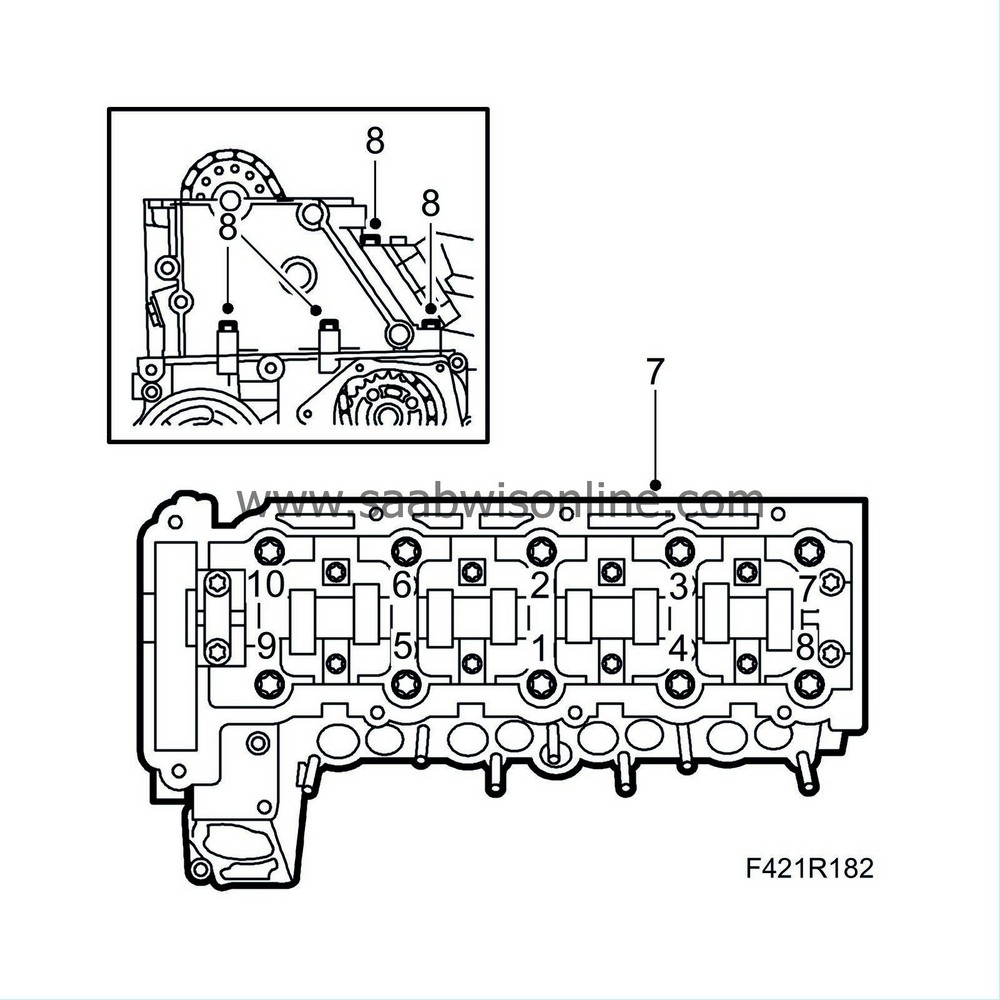Cylinder head
| Cylinder head |
(in-situ)
| To remove |
| Important | ||
|
The cylinder head may only be removed if the engine is at room temperature. |
||
| 1. |
Cover the wings and undo the expansion tank cap to release any overpressure.

|
|
| 2. |
Remove the battery cover and the negative battery cable.
|
|
| 3. |
Remove the upper engine cover.
|
|
| 4. |
Remove the turbocharger intake hose and plug the turbocharger inlet. Unplug the crankcase ventilation hose and mass air flow sensor connector.
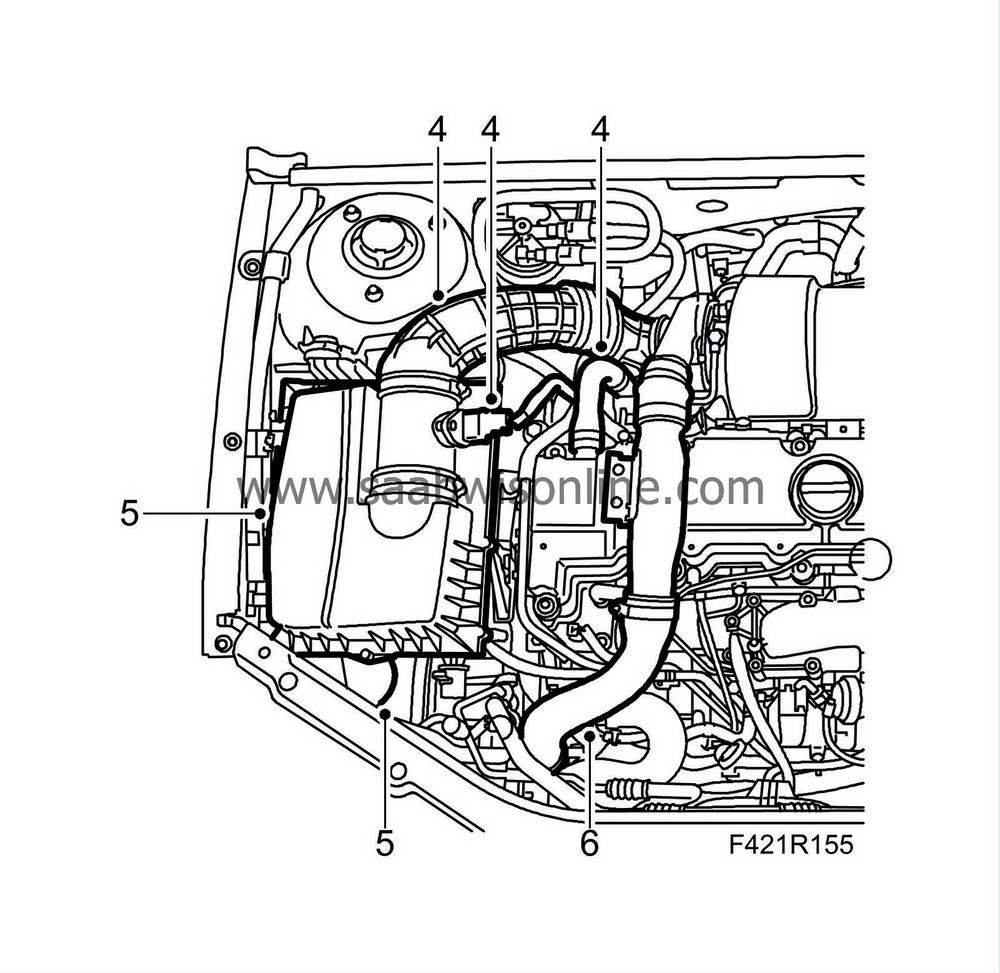
|
|
| 5. |
Remove the air filter housing lid and the air filter. Detach the intake hose and remove the filter housing.
|
|
| 6. |
Remove the charge air hose and charge air pipe from the turbocharger, and the charge air pipe from the fan cowling. Plug the connections.
|
|
| 7. |
Undo the rear wiring harness mounting from the camshaft cover.
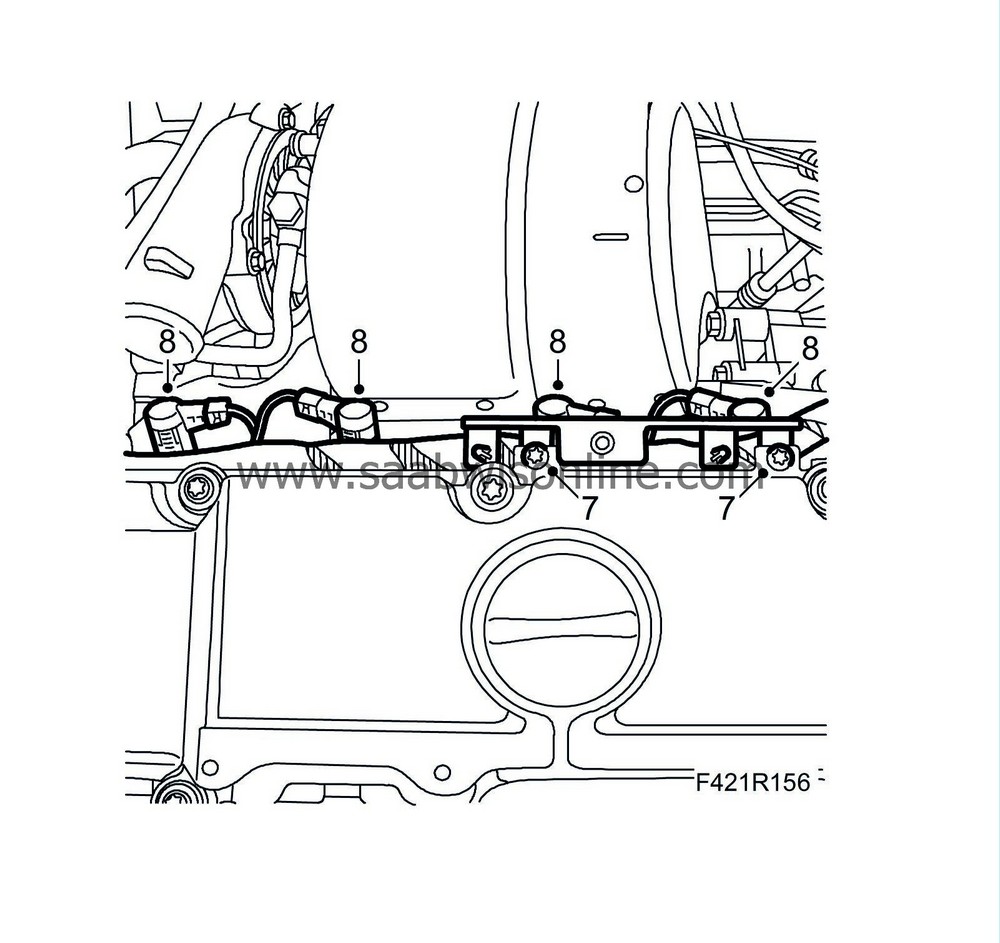
|
|
| 8. |
Disconnect the glow plug connectors and bend aside the wiring harness.
|
|
| 9. |
Remove the lower bolt from the cable duct and lifting eye. Remove the heat shields from the exhaust manifold and turbocharger.
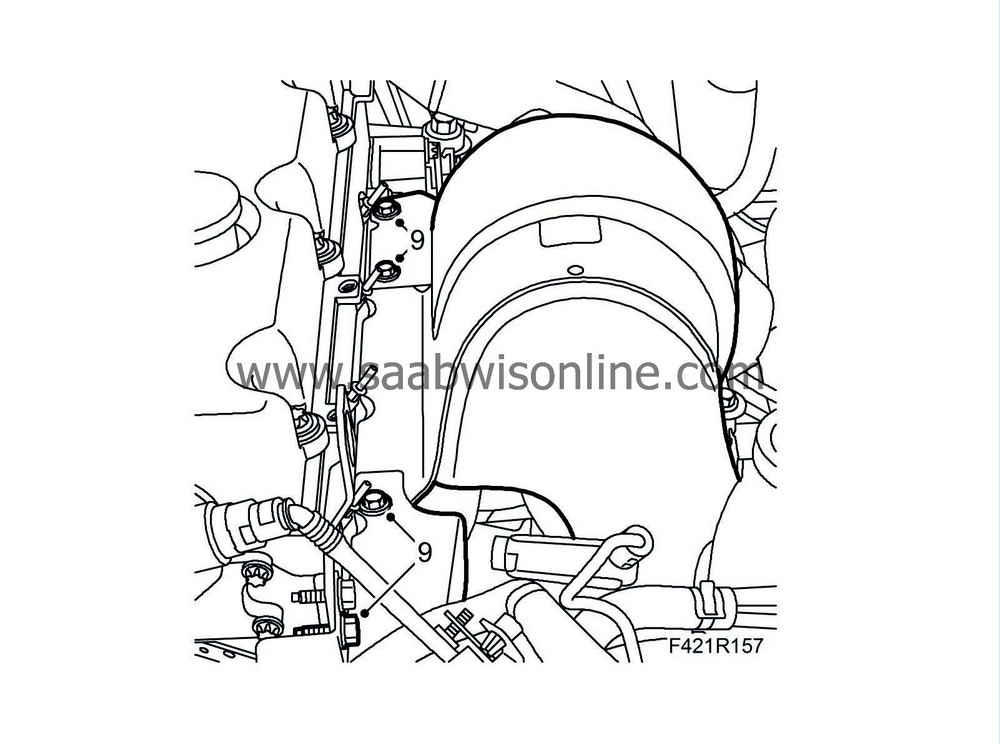
|
|
| 10. |
Raise the car and remove the right-hand front wheel and right-hand wing liner.
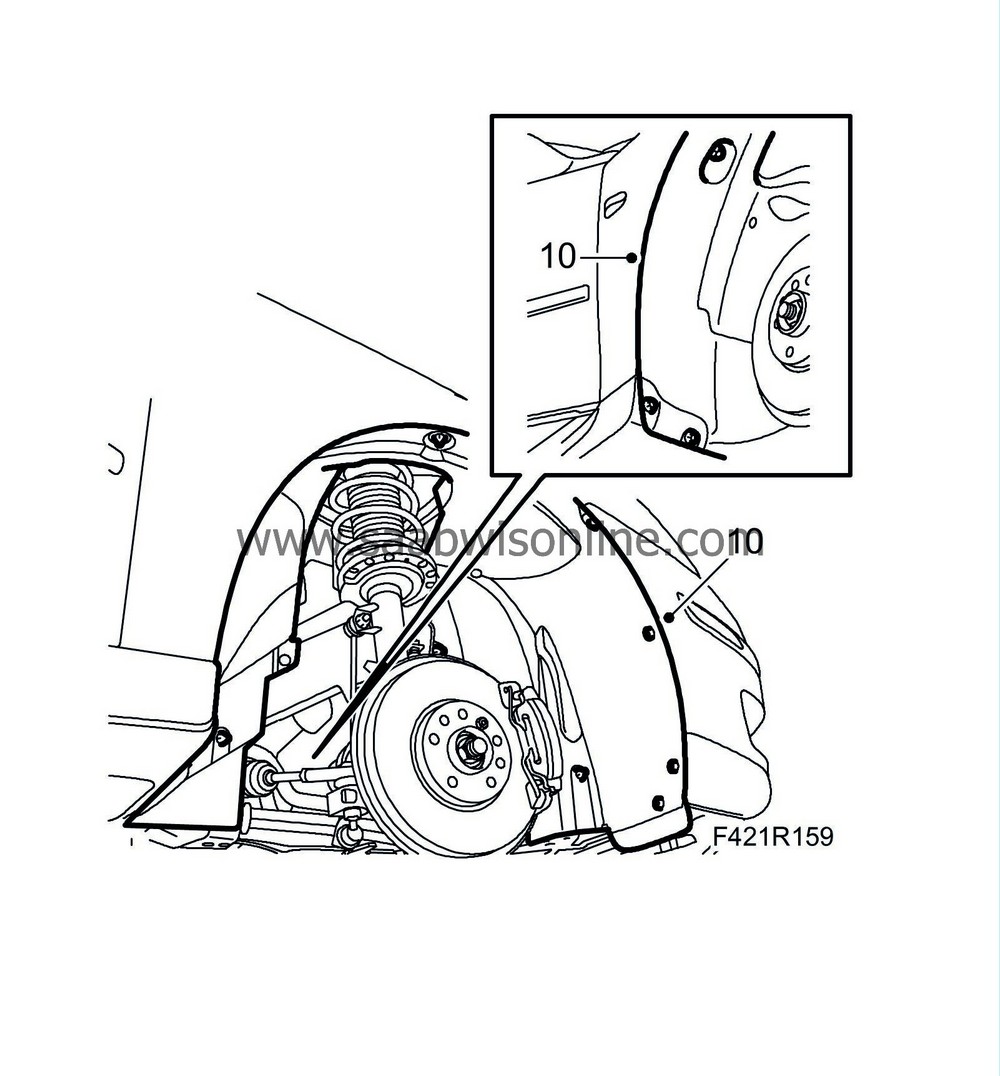
|
|
| 11. |
Remove the spoiler shield. Disconnect the headlight washer hose and unplug and remove the connector.
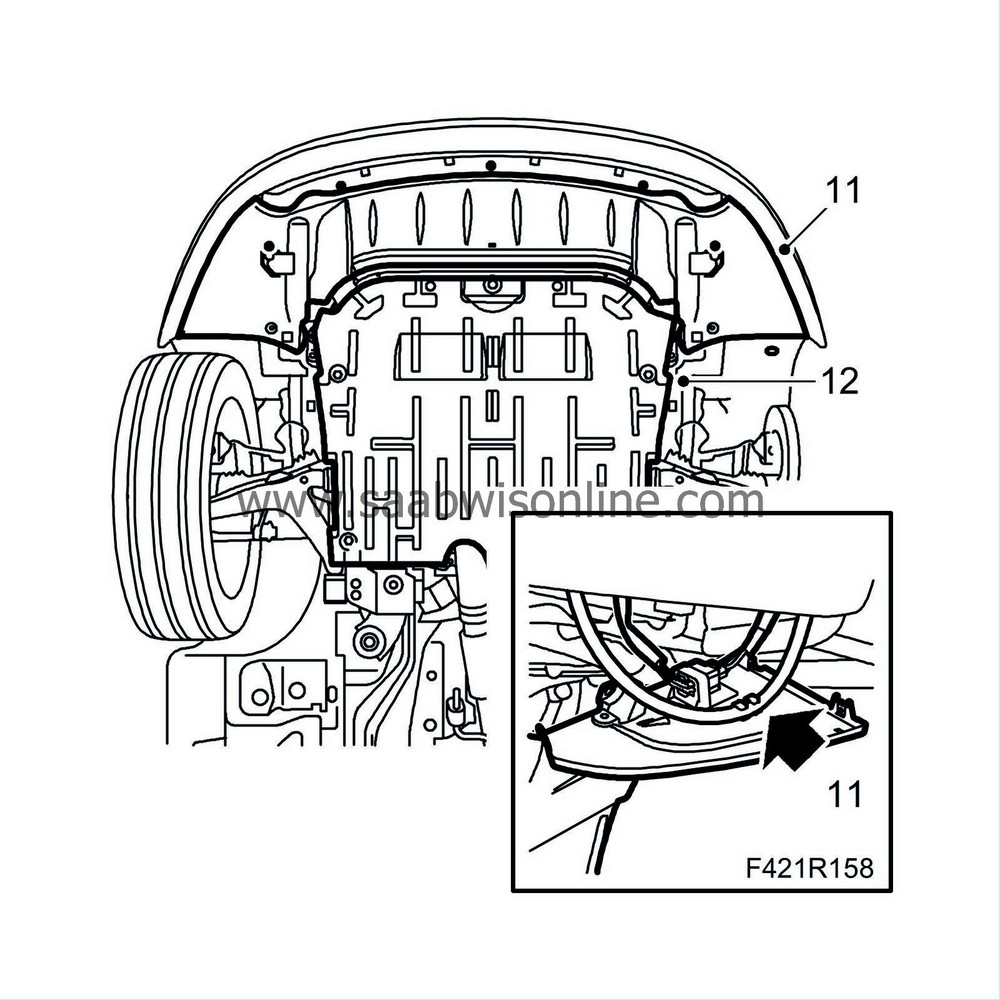
|
|
| 12. |
Remove the lower engine cover.
|
|
| 13. |
Place a suitable receptacle under the car and drain the coolant.
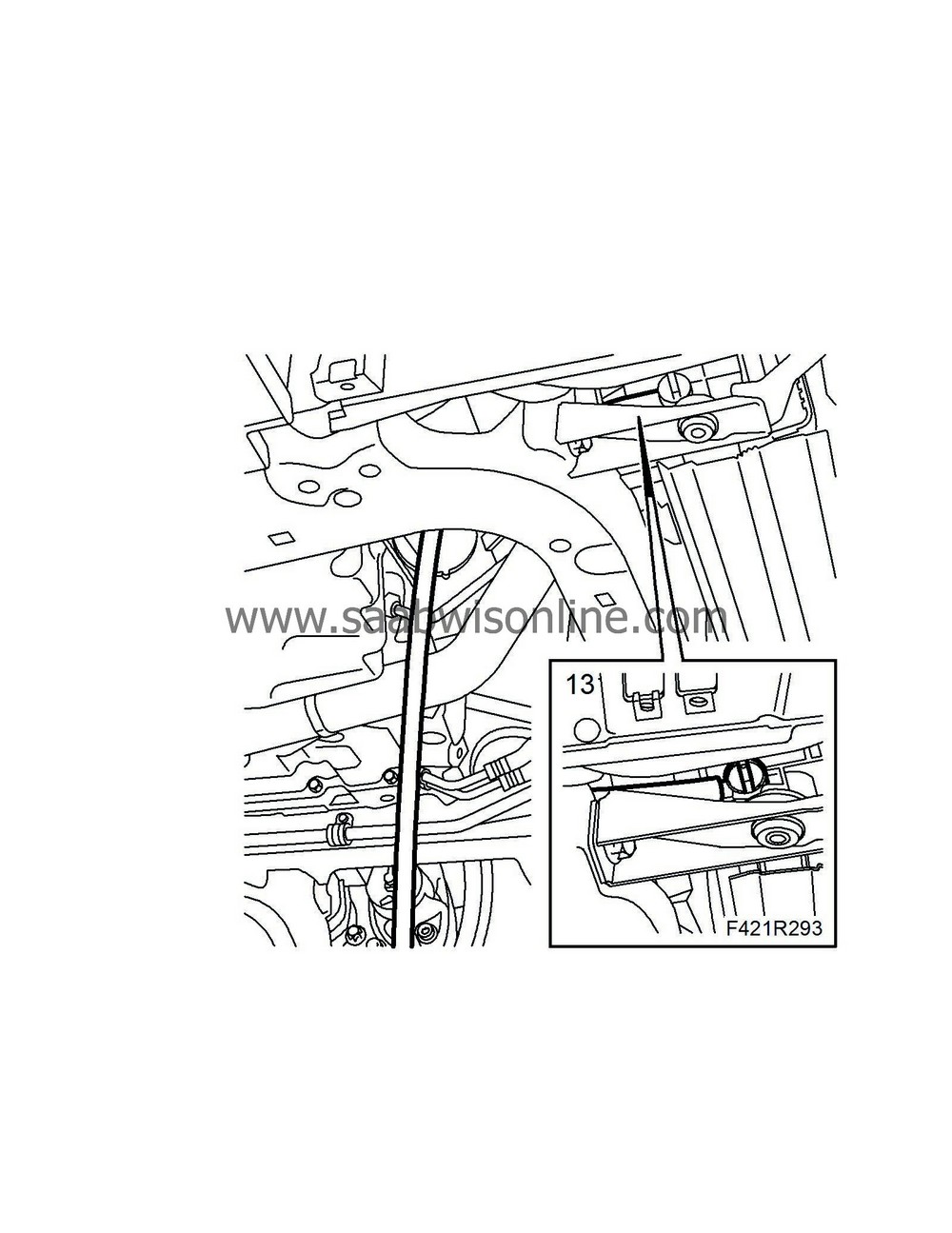
|
|
| 14. |
Mark the belt's direction of rotation. Detension and remove the poly-V-belt.
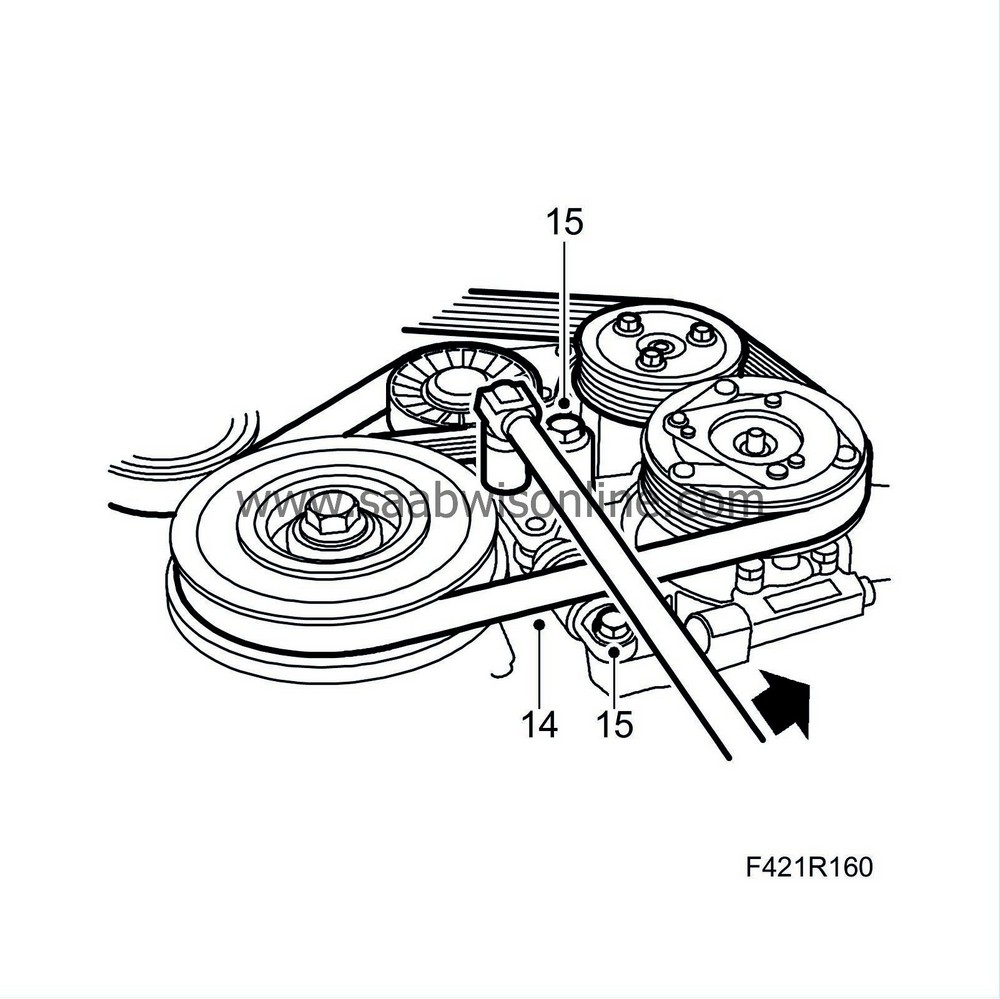
|
|
| 15. |
Remove the belt tensioner. Place the belt tensioner standing upright.
|
|
| 16. |
Remove the coolant pipe from the gearbox and cylinder block.
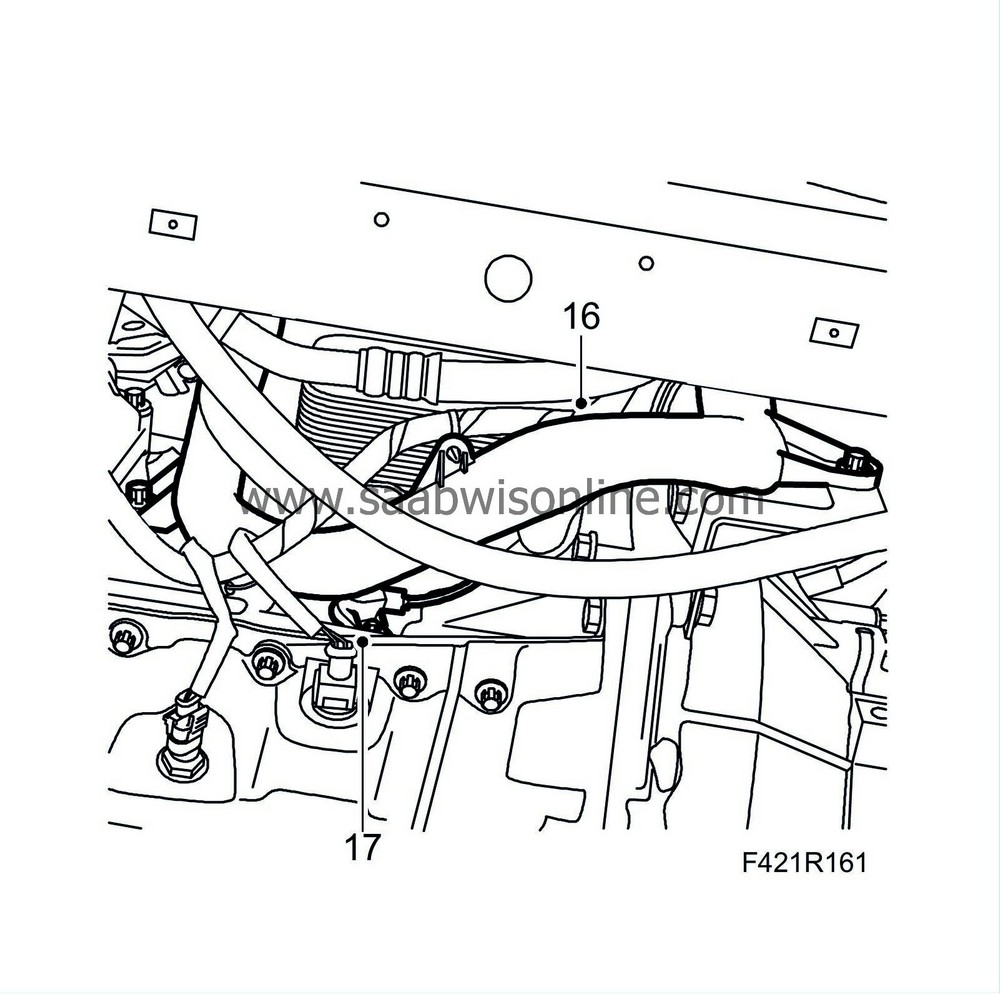
|
|
| 17. |
Remove the crankshaft position sensor.
|
|
| 18. |
Remove the front nut securing the exhaust pipe to the turbocharger.
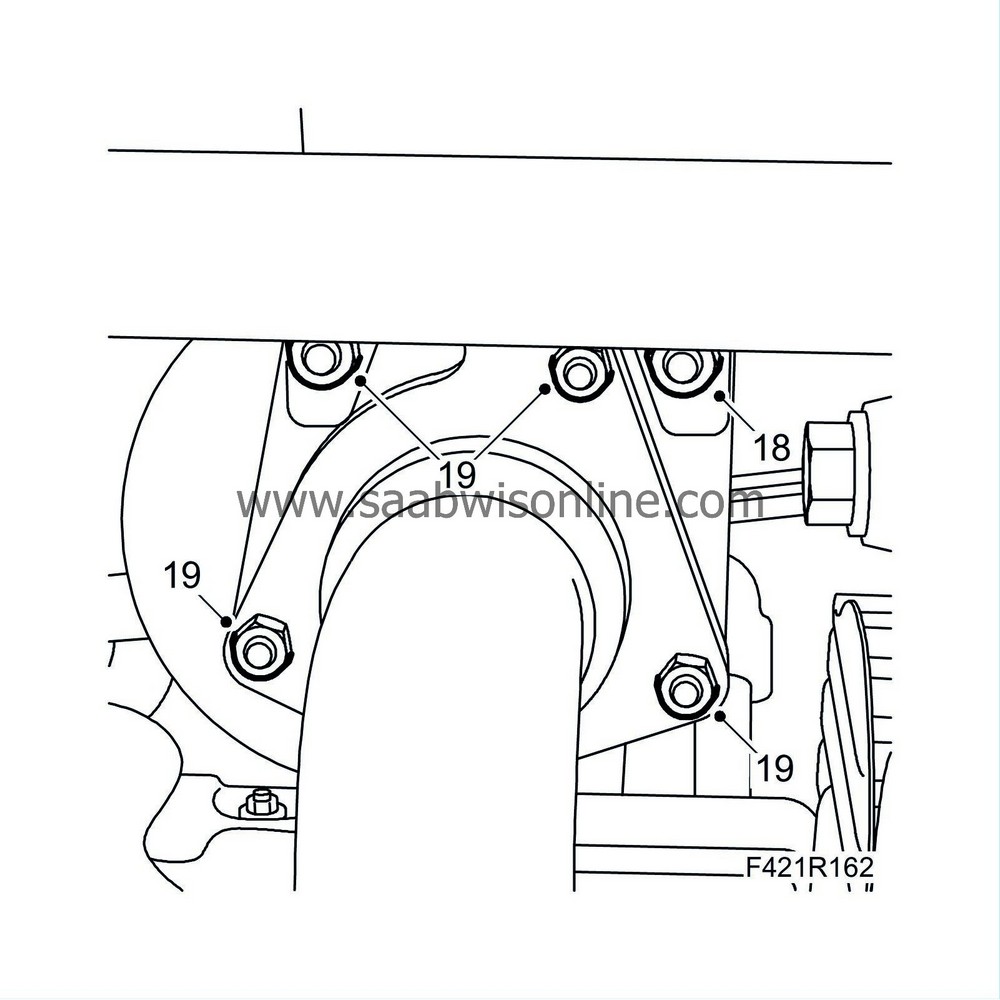
|
|
| 19. |
Remove the nuts from the catalytic converter bracket and front exhaust pipe.
|
|
| 20. |
Remove the bracket from the intermediate shaft. Suspend the exhaust pipe with a
83 95 212 Strap
.

|
|
| 21. |
Lower the car. Remove the hose from the turbocharger vacuum box and the two remaining nuts from the exhaust pipe and turbocharger. Remove the catalytic converter.
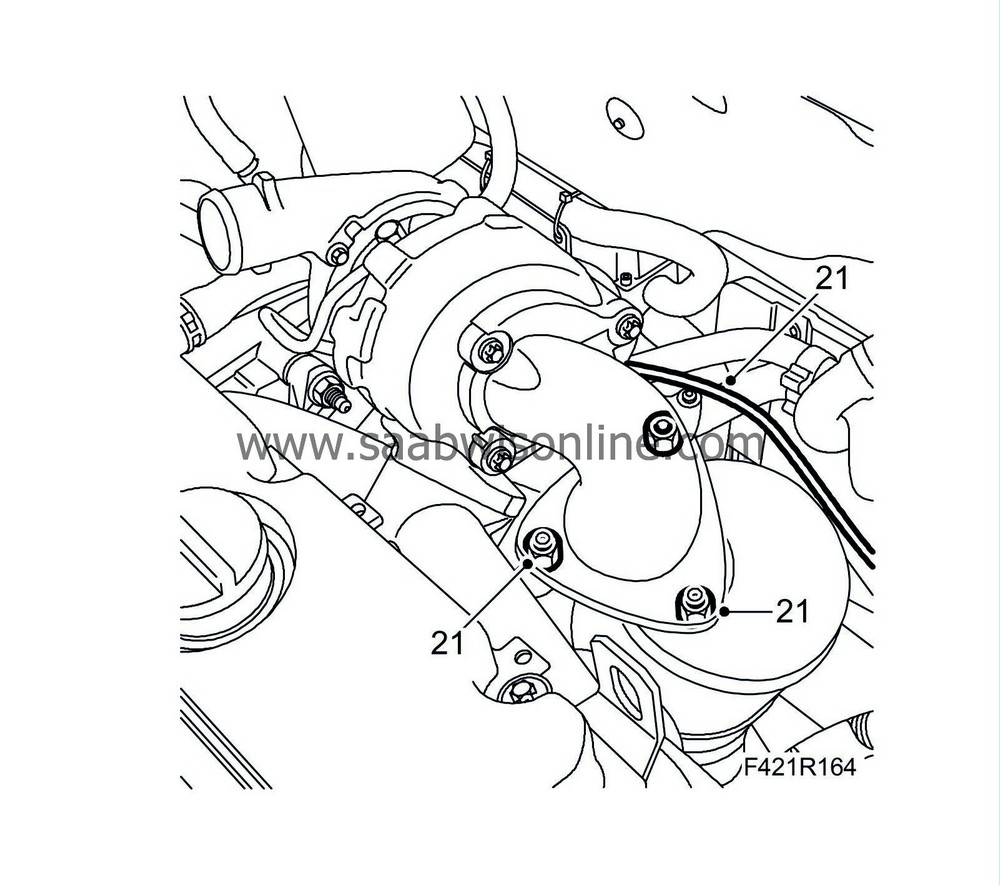
|
|
| 22. |
Remove the heat shield from the starter motor.
|
|
| 23. |
Remove the bolts from the generator and starter motor cable duct.
|
|
| 24. |
Disconnect the turbocharger's oil return pipe from the cylinder block.
|
|
| 25. |
Disconnect the turbocharger's oil return pipe from the turbocharger.
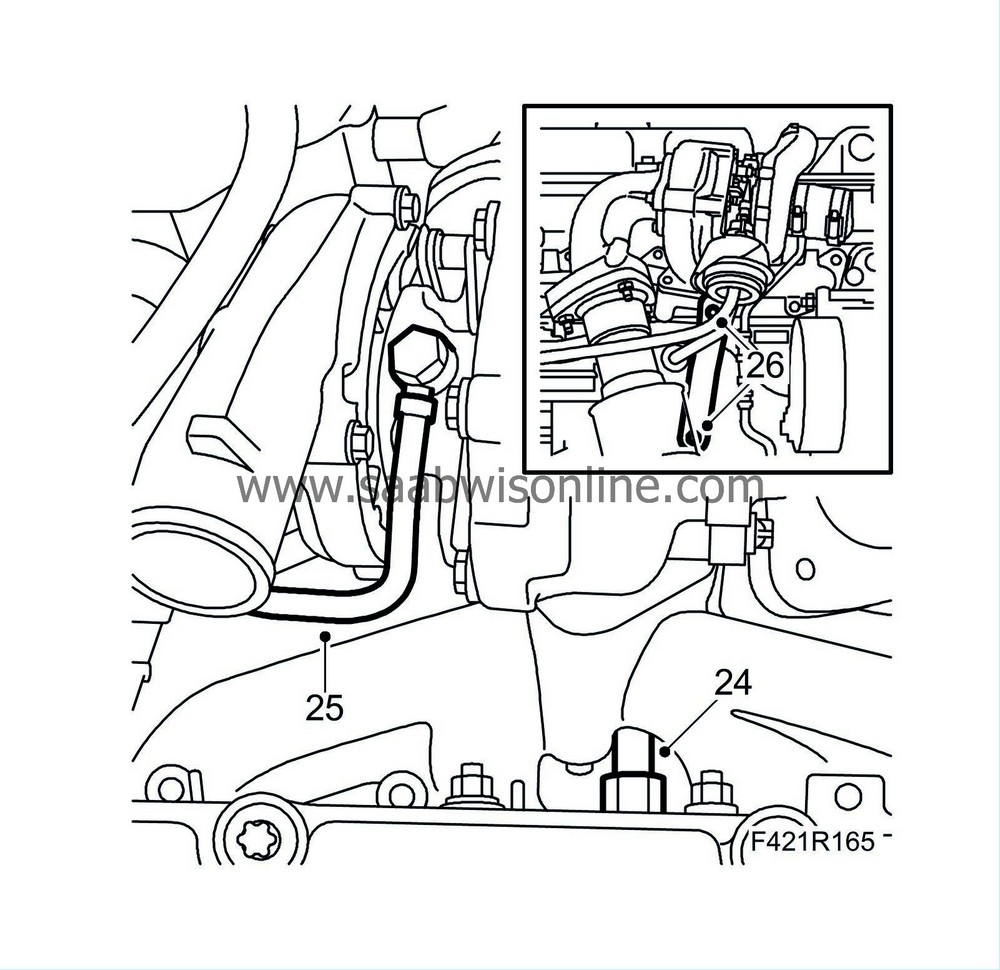
|
|
| 26. |
Remove the exhaust manifold support.
|
|
| 27. |
Remove the turbocharger delivery hose from the throttle body.
|
|
| 28. |
Disconnect the hose from the swirl throttle's vacuum box and the screw securing the connector bracket for the crankshaft position sensor.
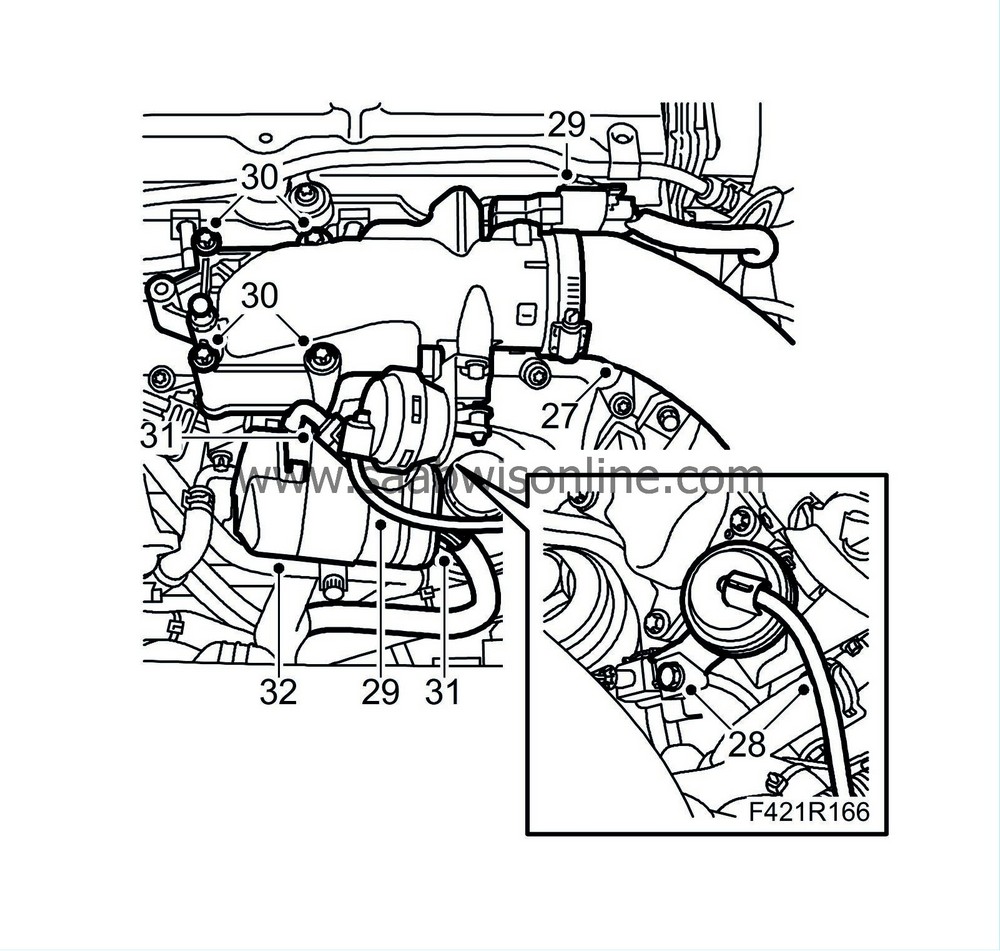
|
|
| 29. |
Disconnect the pressure/temperature sensor connector and the vacuum hose from the throttle body.
|
|
| 30. |
Remove the throttle body.
|
|
| 31. |
Disconnect the EGR valve connector and coolant hoses.
|
|
| 32. |
Remove the EGR valve.
|
|
| 33. |
Disconnect the coolant pipe and bracket from the cylinder head and move it aside.
|
|||||||||||||||||||||||||||||||||
| 34. |
Disconnect the return hoses from the fuel bridges. Place a receptacle under the car to catch any fuel spills.
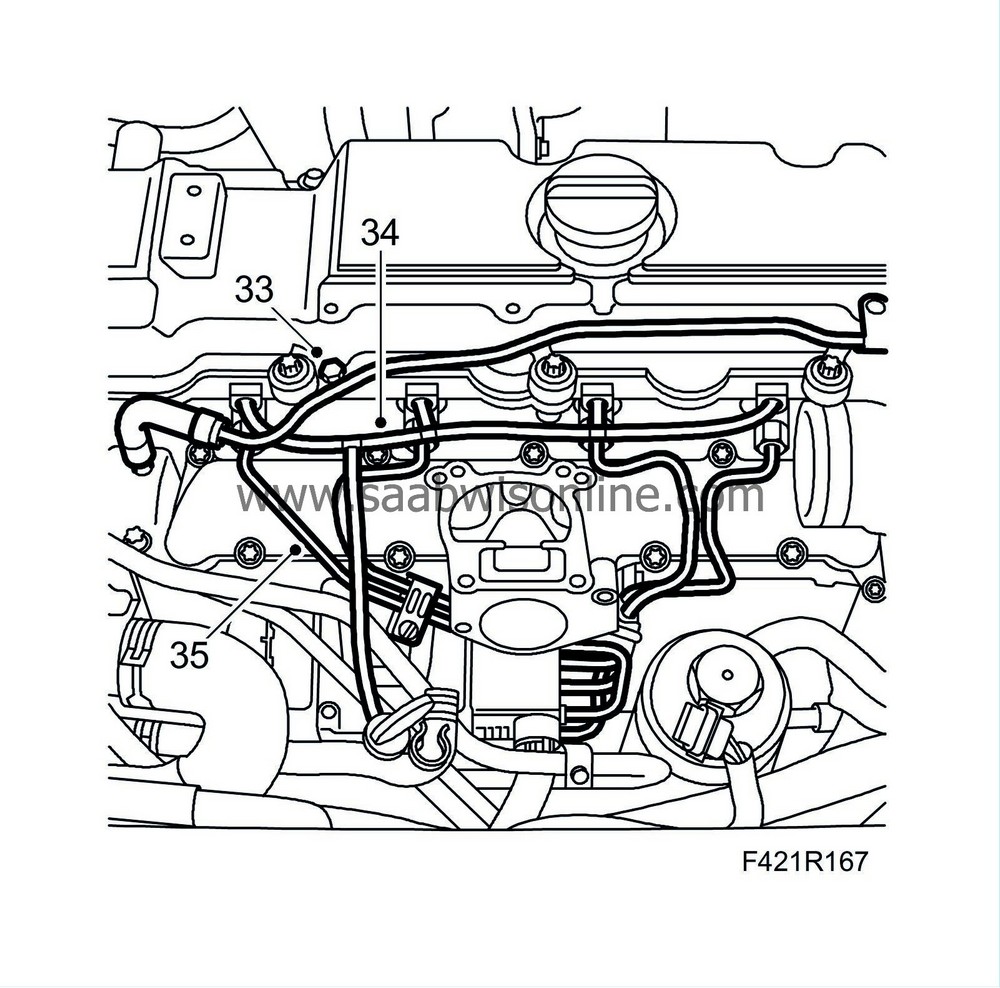
|
|
| 35. |
Remove the fuel delivery pipes.
|
|
| 36. |
Unplug the connectors for the A/C pressure sensor and coolant temperature sensor.
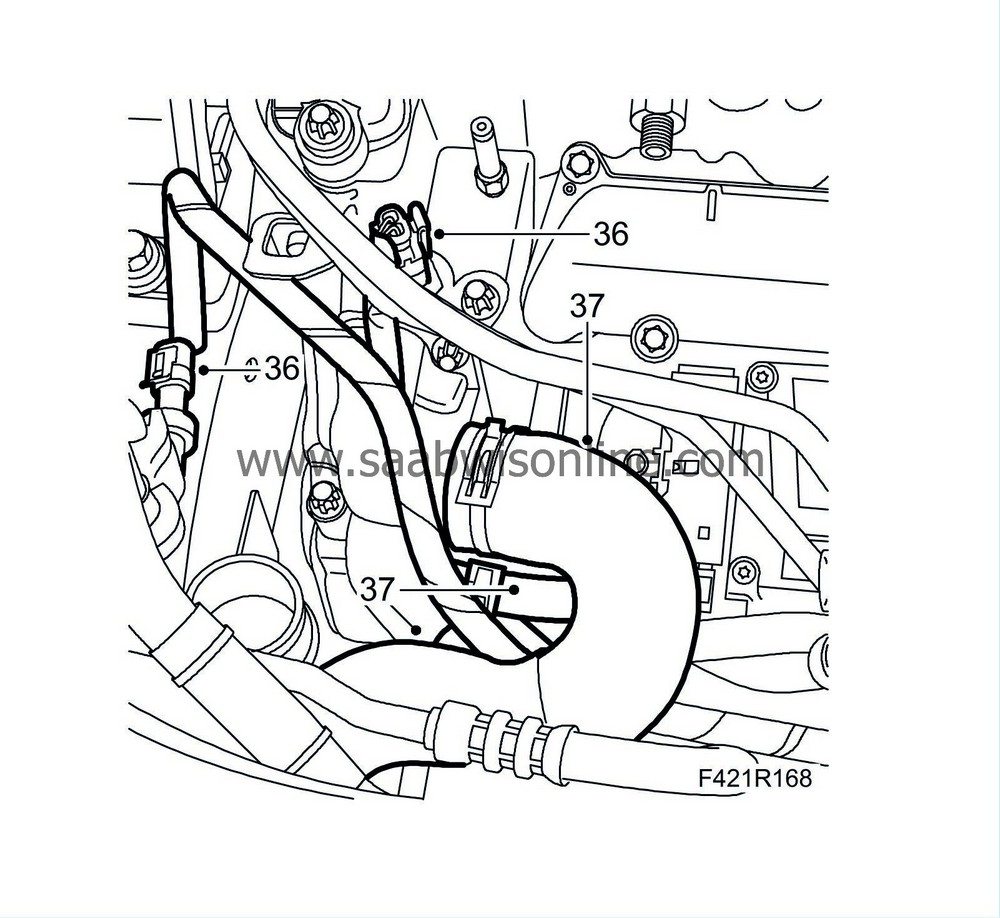
|
|
| 37. |
Disconnect the three hoses from the thermostat housing. Poke down the lower hose.
|
|
| 38. |
Split the fuel pipes using
83 95 261 Fuel line tool
and seal them. Catch and mop up any fuel spills with a rag. Remove the pipes from the fuel pump.
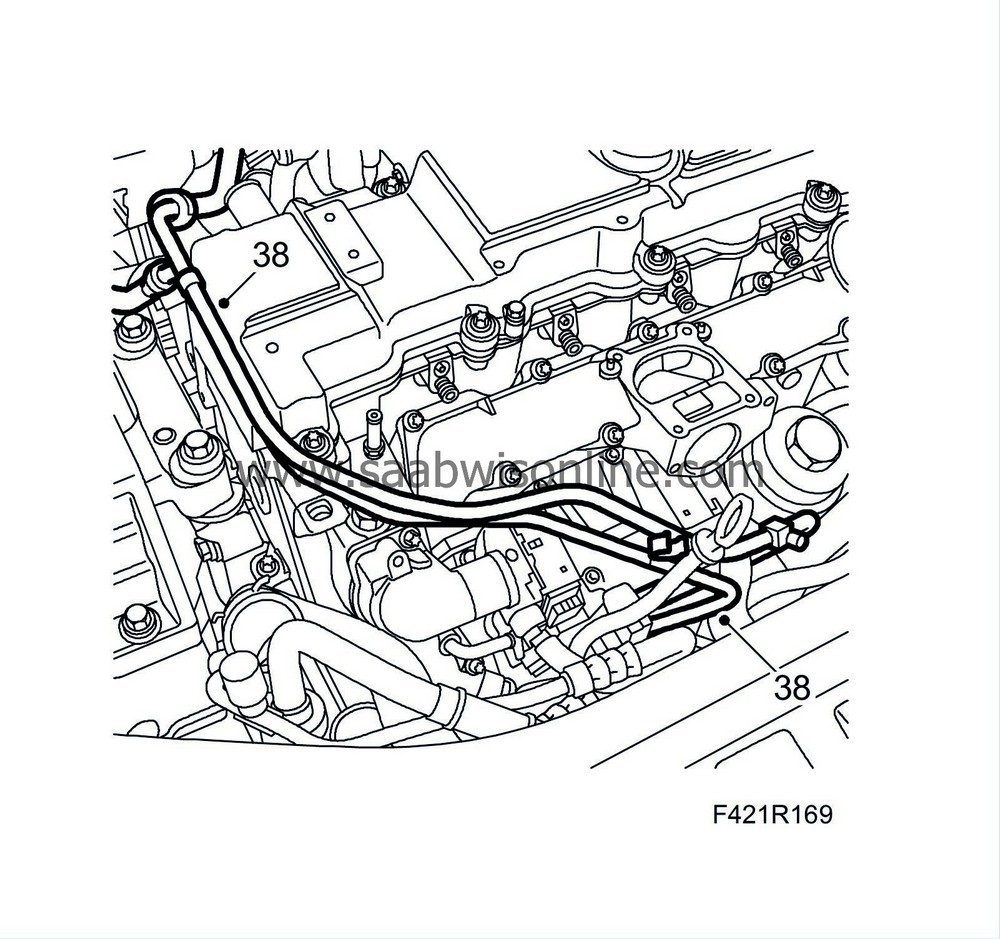
|
|
| 39. |
Remove the bolts securing the cable bracket by the vacuum pump.
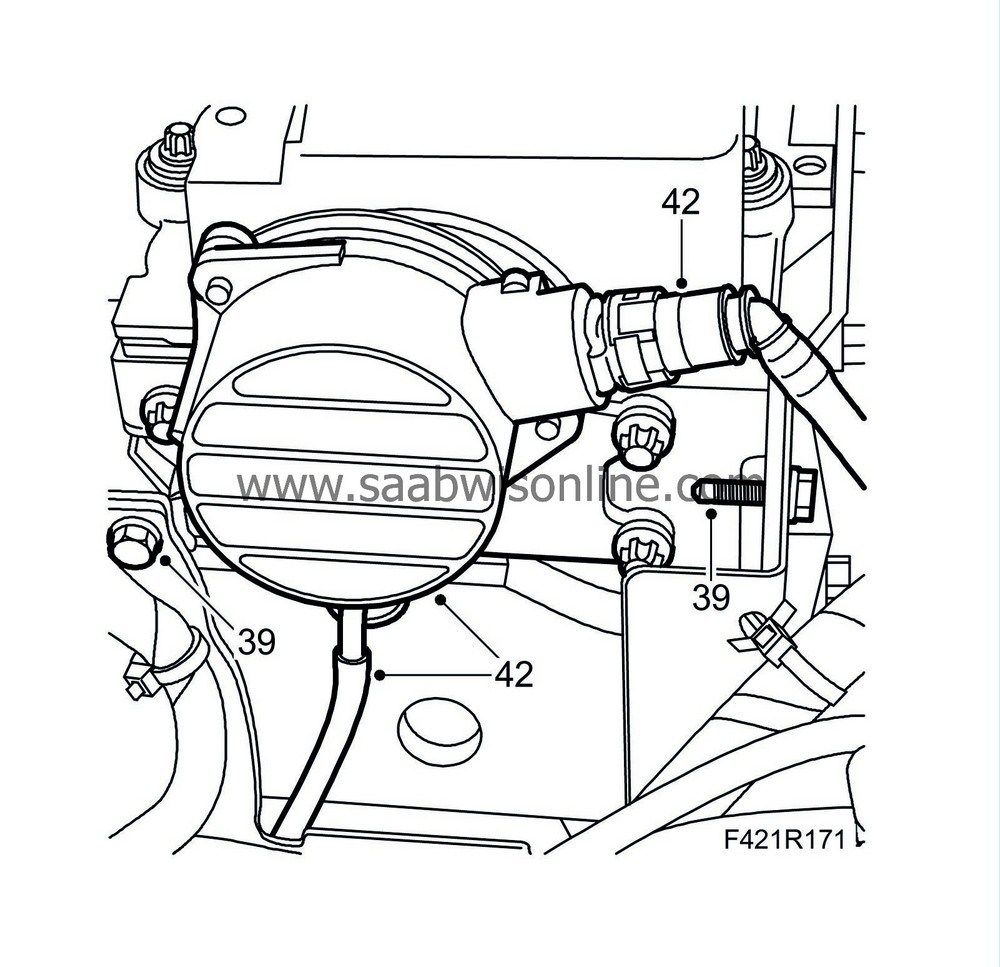
|
|
| 40. |
Slacken the lower bolt on the generator and remove the upper bolt.
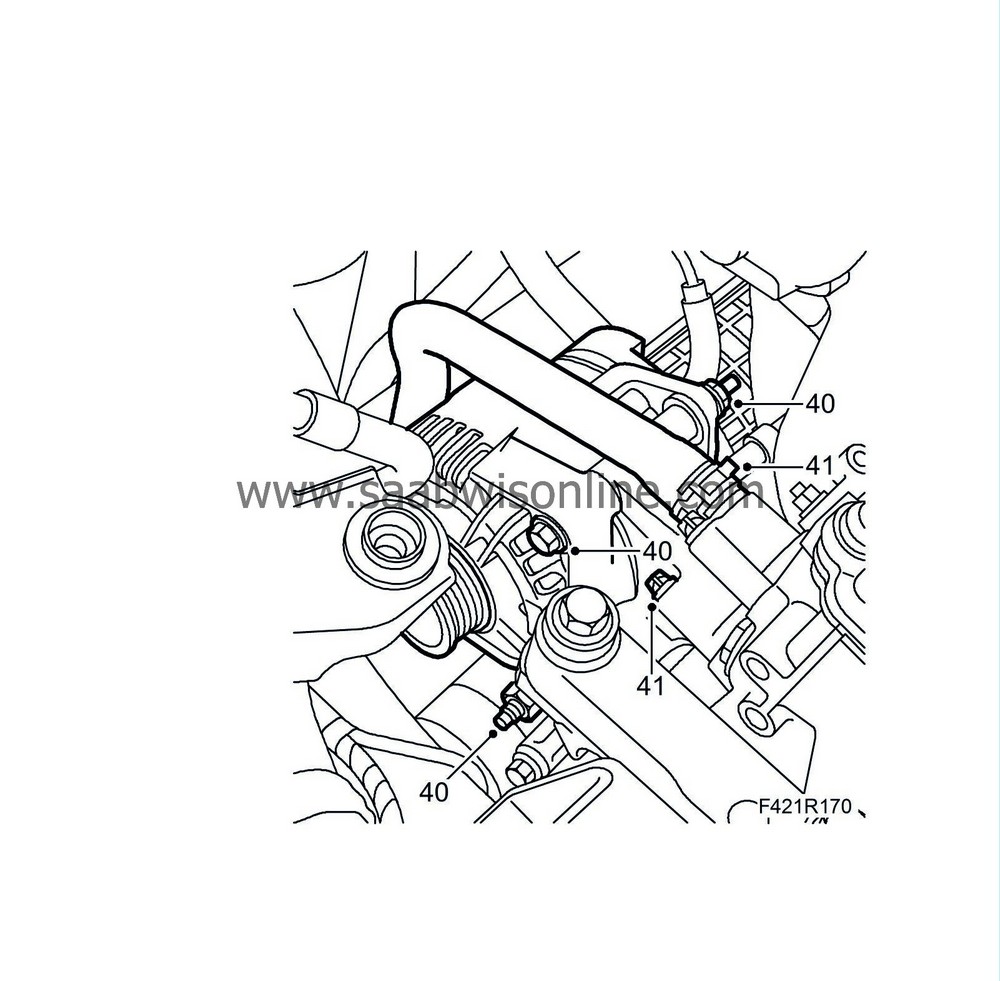
|
|
| 41. |
Remove the bolts securing the generator bracket.
|
|
| 42. |
Disconnect the hoses from the vacuum pump and remove the vacuum pump. Have a rag at hand to catch any oil spills.
|
|
| 43. |
Remove the camshaft cover.
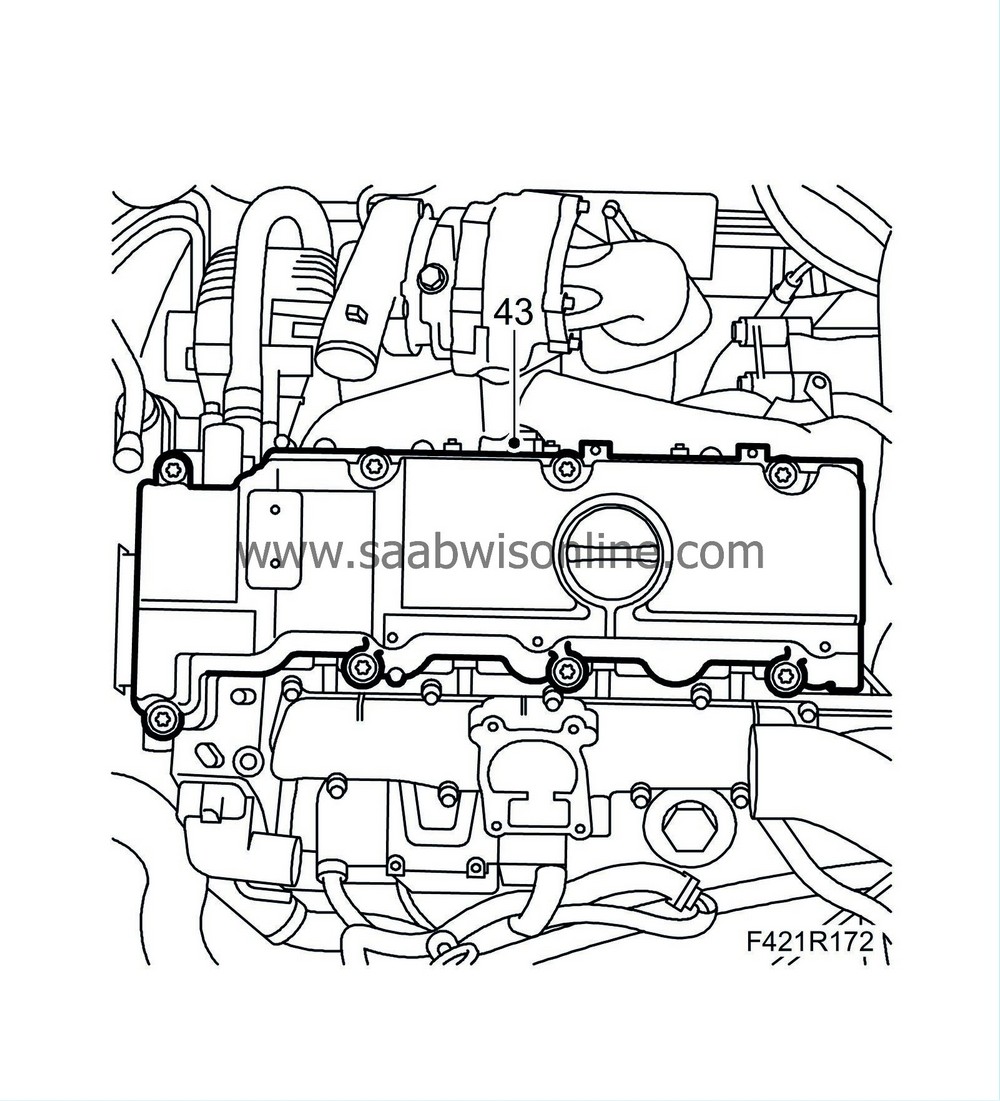
|
|
| 44. |
Turn the crankshaft to just before the mark for TDC for cylinder 1. Check that both the cams for cylinder 1 are pointing obliquely upward.

|
|
| 45. |
Raise the car and insert
83 95 352 Adjustment tool, crankshaft
into the hole for the crankshaft position sensor. Press the tool in while turning the crankshaft to zero. The tool should enter a recess in the crankshaft and lock it.
|
|
| 46. |
Slacken the screws securing the clamps holding the power steering pipe to the subframe.
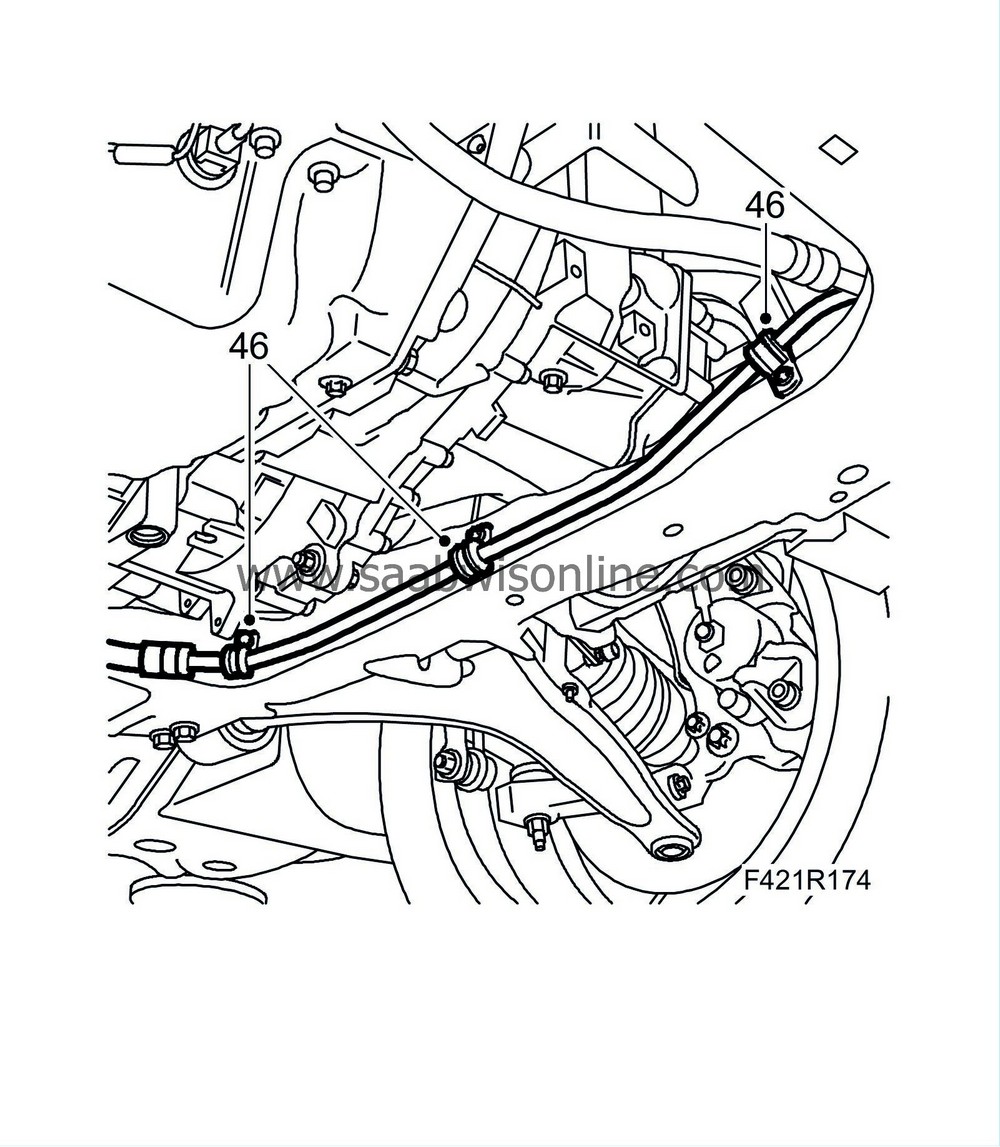
|
|
| 47. |
Fit
83 96 152 Centring kit, engine
to the subframe.
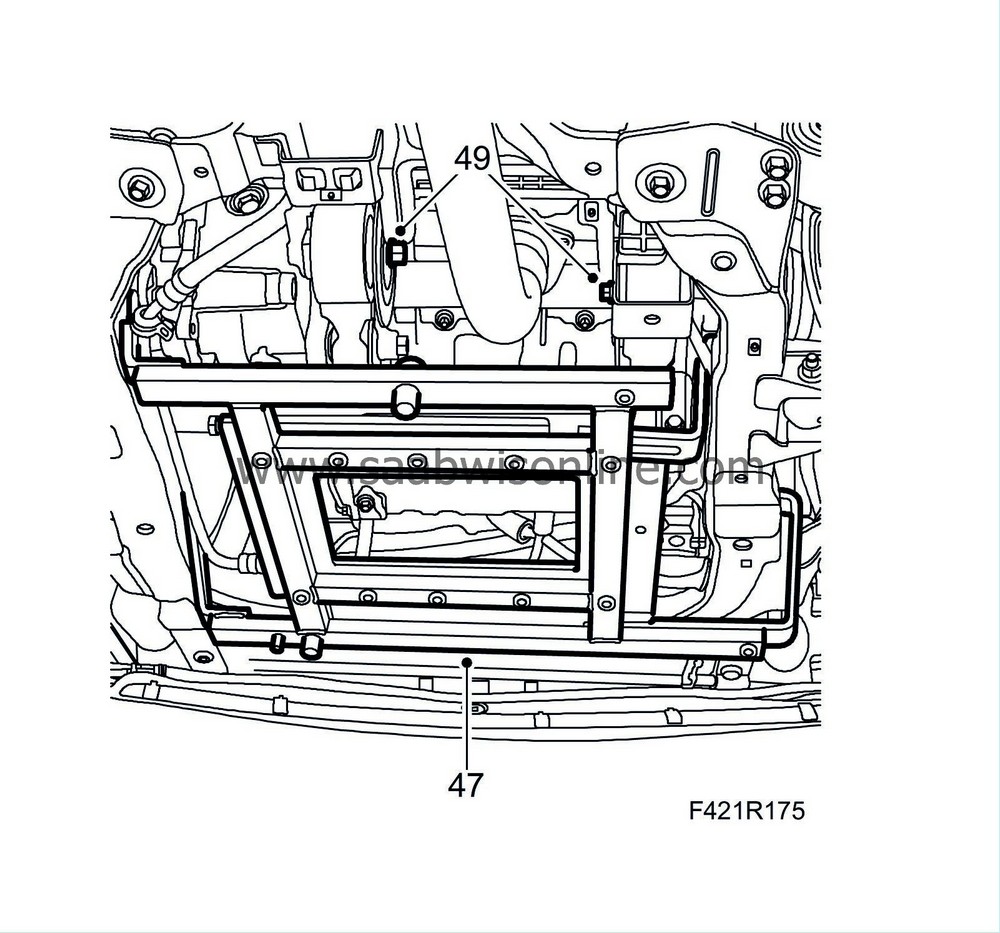
|
|
| 48. |
Raise the centring drift bolts so that the slits in the adjustment bolts are fully visible. See
Centring tool, engine and subframe
.
|
|
| 49. |
Undo the rear bolts securing the torque arm.
|
|
| 50. |
Lower the car and fit
83 95 386 Adjustment tool, camshaft
to the camshaft and cylinder head.
|
|
| 51. |
Remove the right-hand engine pad.
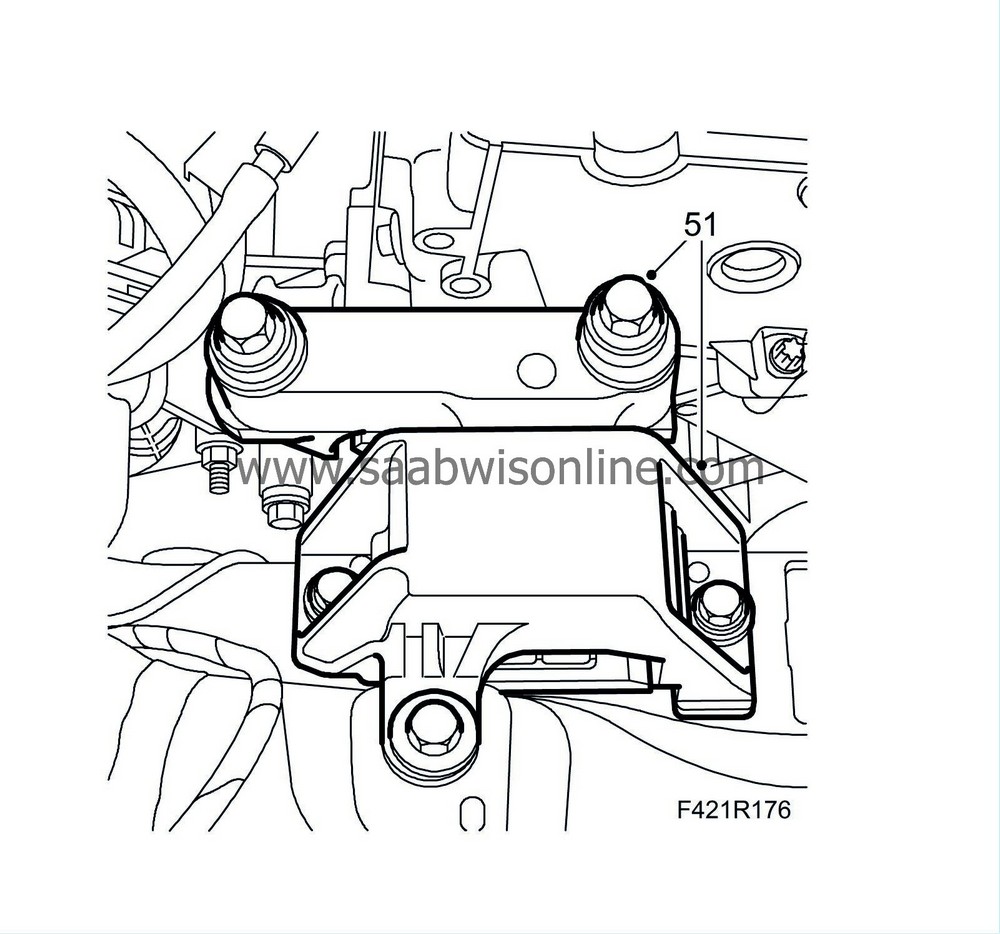
|
|
| 52. |
Remove the bolts from the cover on the timing cover. Carefully insert a pallet knife behind the cover and prise it off.
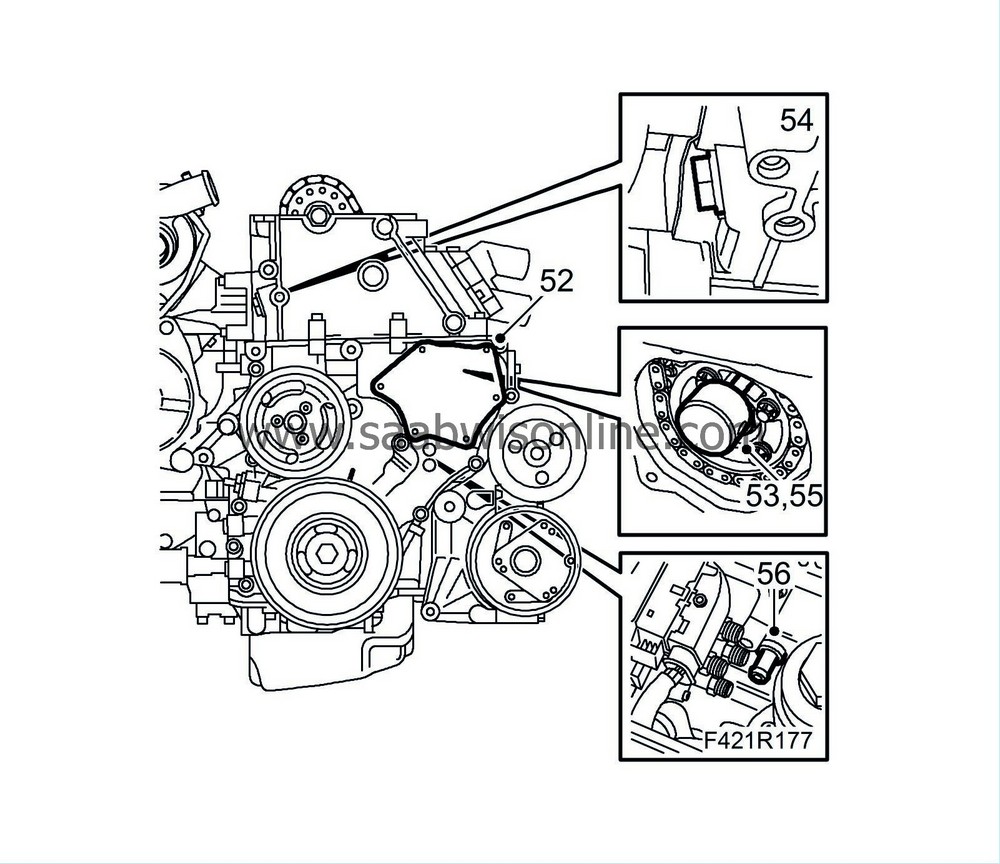
|
|
| 53. |
Insert
83 95 337 Adjustment tool, fuel pump
into the recess on the fuel distribution pump.
|
|
| 54. |
Remove the upper timing chain tensioner.
|
|
| 55. |
Remove
83 95 337 Adjustment tool, fuel pump
from the outlet on the fuel pump.
|
|
| 56. |
Place a receptacle under the car. Undo the drain nipple by the fuel distribution pump using an 8-mm hex key. Connect a hose to the engine block drain nipple. Drain the coolant.
|
|
| 57. |
Attach a long cable tie to the timing chain. This will be used as a handle.
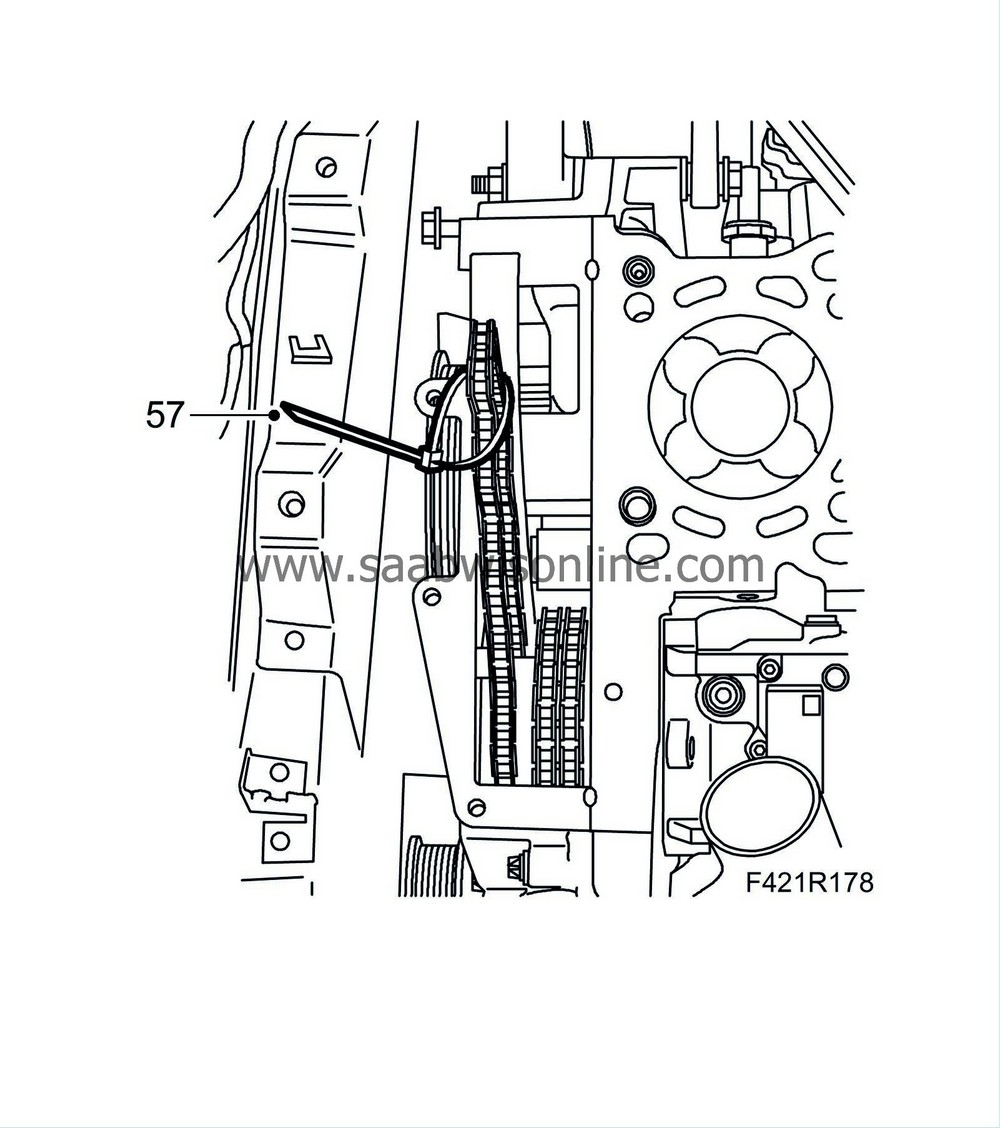
|
|
| 58. |
Remove the camshaft sprocket using an open-ended wrench on the hexagonal key to hold the camshaft still.
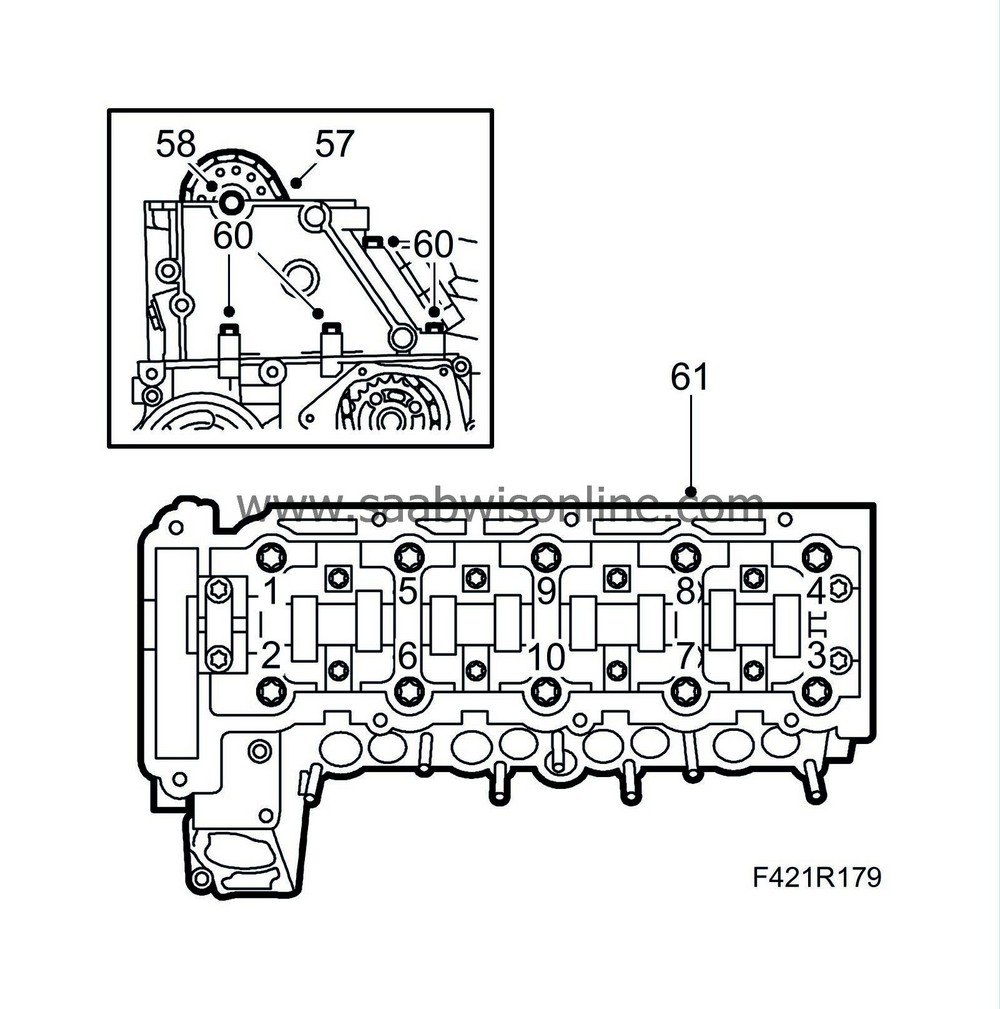
|
|
| 59. |
Carefully place the chain to one side.
|
|
| 60. |
Remove the four bolts holding the cylinder head to the timing cover.
|
|
| 61. |
Remove the cylinder head by undoing the bolts in the order illustrated. Lift the cylinder head straight up and place it in such a way as not to damage the injector nozzles, glow plugs or valves.
|
|
| To fit |
| 1. |
Blow the bolt holes in the cylinder block clean using compressed air.
|
|
| 2. |
Clean any gasket remains from the sealing surfaces of the cylinder bores, cylinder head and cylinder block. Check the flatness of the cylinder head and cylinder block with a steel rule and check the sealing surfaces for damage. Planing the cylinder head and cylinder block is prohibited.
|
|
| 3. |
Sparingly apply
83 95 691 Flange sealant
as illustrated.
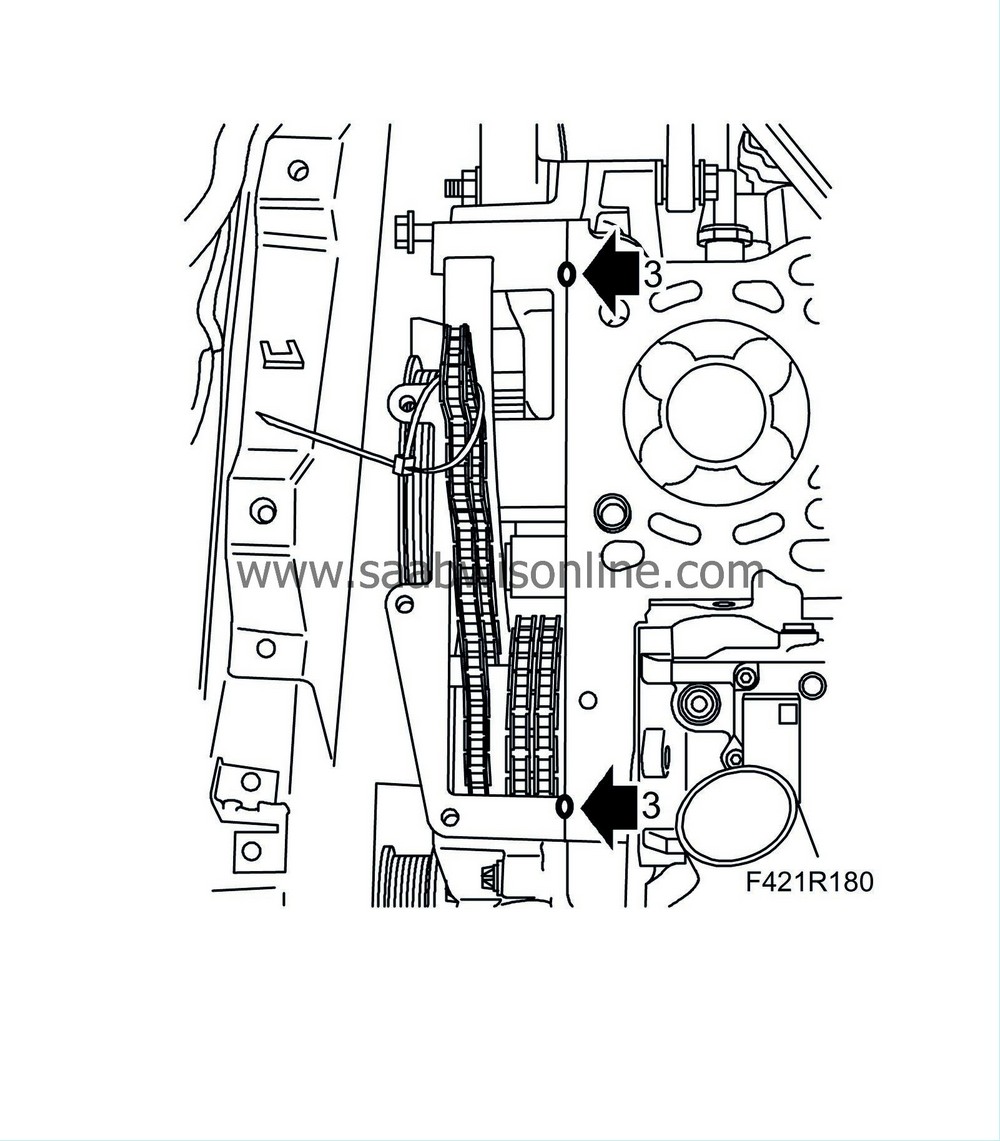
|
|
| 4. |
Place a new gasket of the same thickness as the old one on the cylinder block (1 groove = 1.3 mm, 2 grooves = 1.4 mm). Place a new gasket on the front exhaust pipe connection.
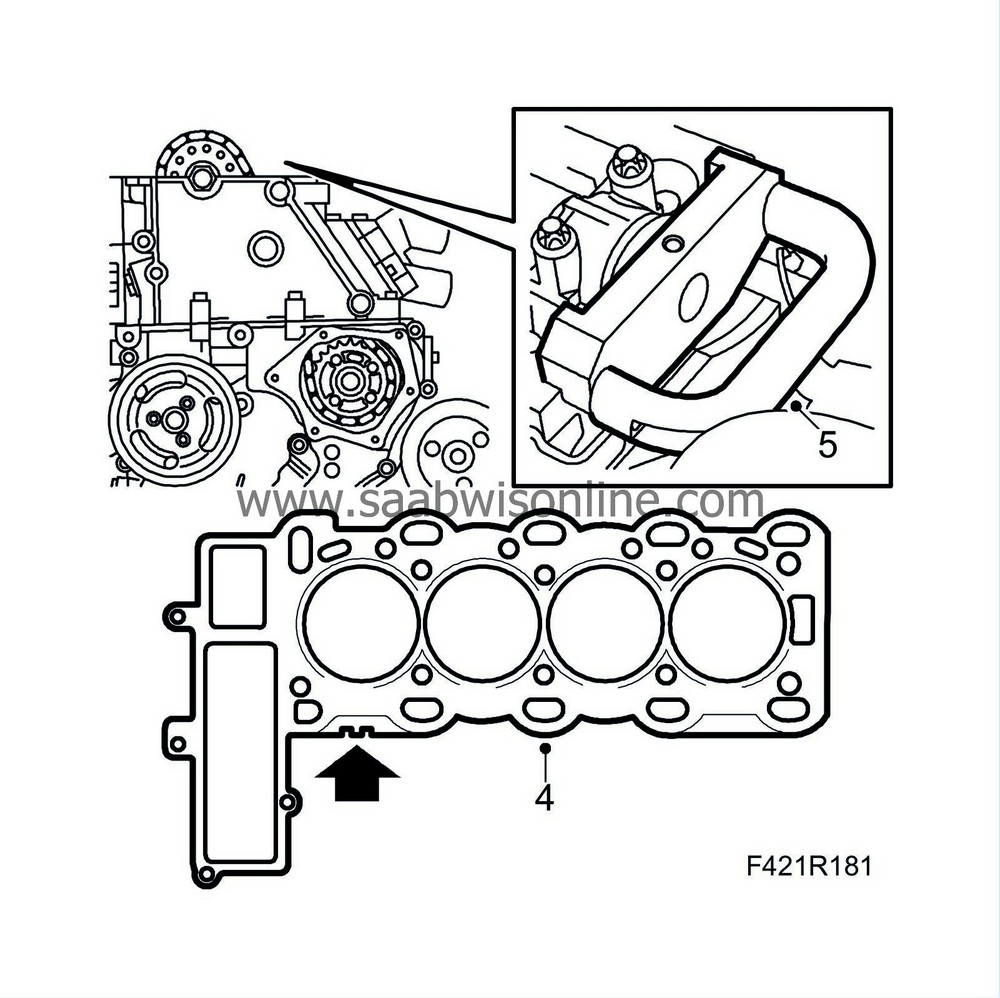
|
|
| 5. |
Fit
83 95 386 Adjustment tool, camshaft
to the camshaft and cylinder head. If necessary, turn the camshaft using an open-ended wrench in the hexagonal key while fitting the tool.
|
|
| 6. |
Fit the cylinder head to the cylinder block while lifting up the timing chain into position.
|
|
| 8. |
Refit the bolts in the timing cover.
Tightening torque 20 Nm (15 lbf ft) |
|
| 9. |
Lift up the timing chain and fit the camshaft sprocket so that it runs freely on the camshaft. Fit a new bolt and tighten finger tight.
|
|
| 10. |
Insert
83 95 337 Adjustment tool, fuel pump
into the recess on the fuel distribution pump.
|
|
| 11. |
Fit the adapter for
83 95 394 Adjustment tool, timing chain
to the camshaft sprocket and fit the adjustment tool to the cylinder head.
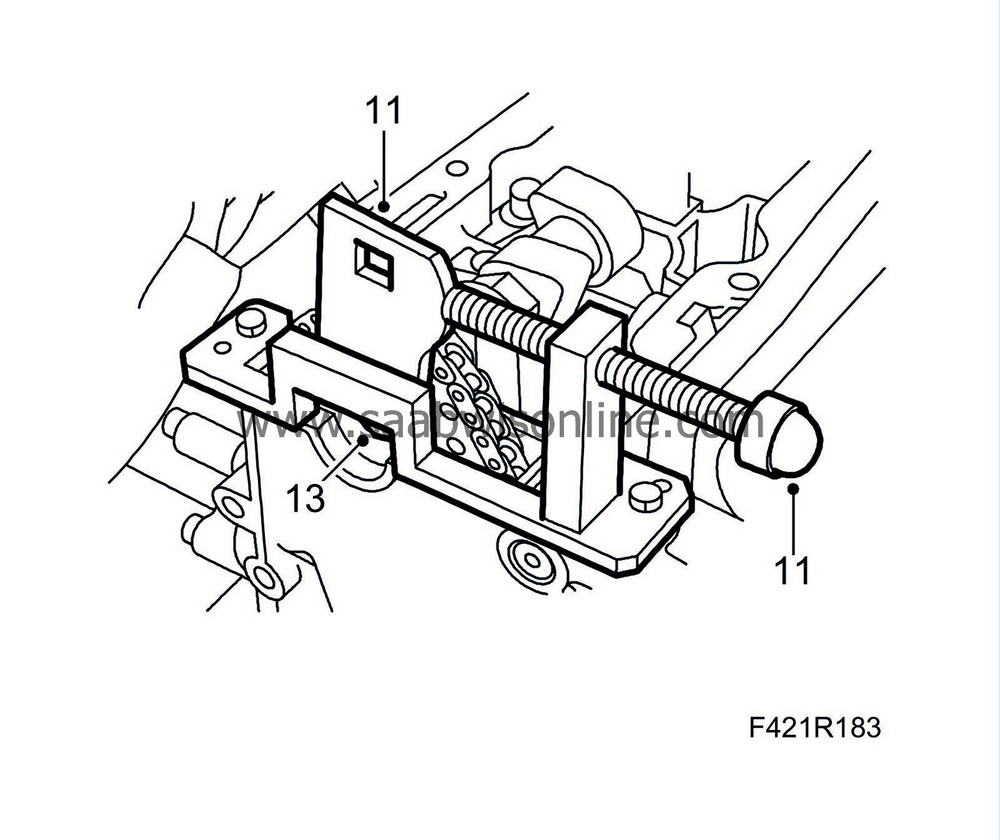
|
|
| 12. |
Fix the position for the adapter on the camshaft sprocket by lightly twisting it anticlockwise with a ratchet handle. Tighten the adjustment screw on the tool.
|
||||||||||
| 13. |
Tighten the bolt securing the camshaft sprocket. Use an open-ended spanner in the hexagonal key to hold the camshaft still.
Tightening torque 90 Nm + 60° (67 lbf ft + 60°) 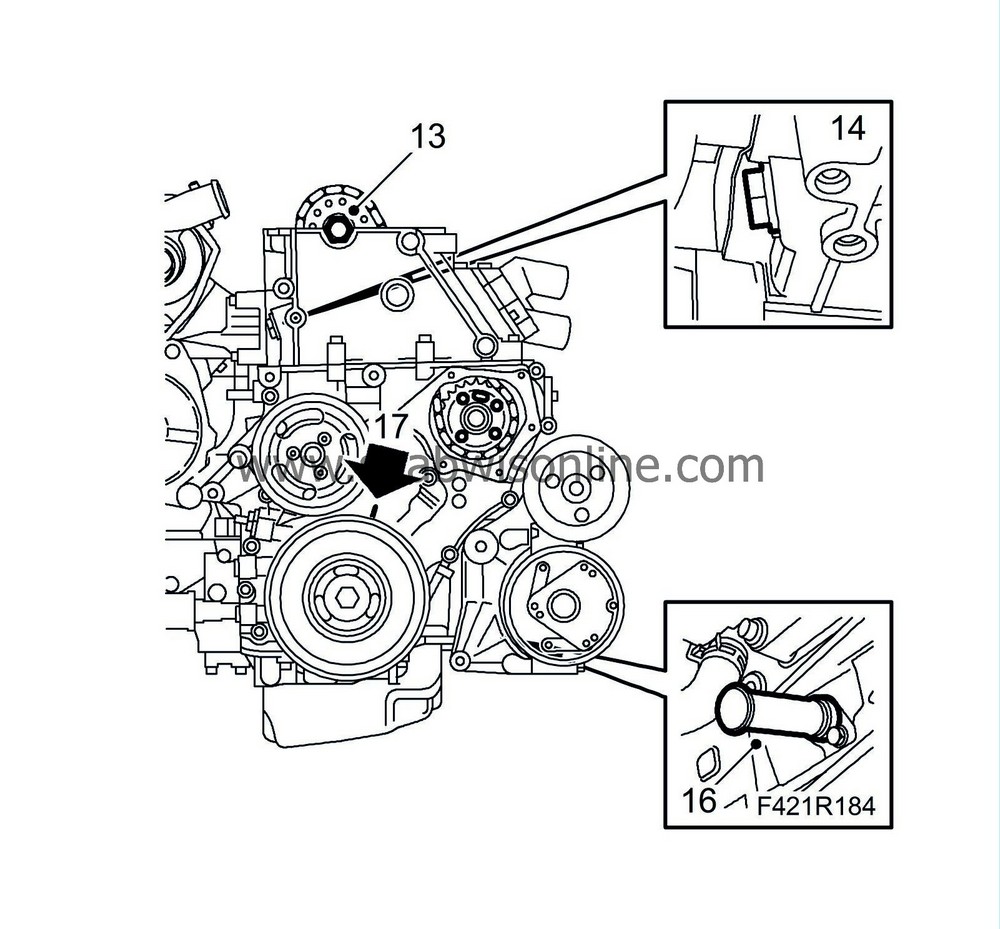
|
|
| 14. |
Fit the chain tensioner for the upper timing chain using a new gasket.
Tightening torque 60 Nm (44 lbf ft) 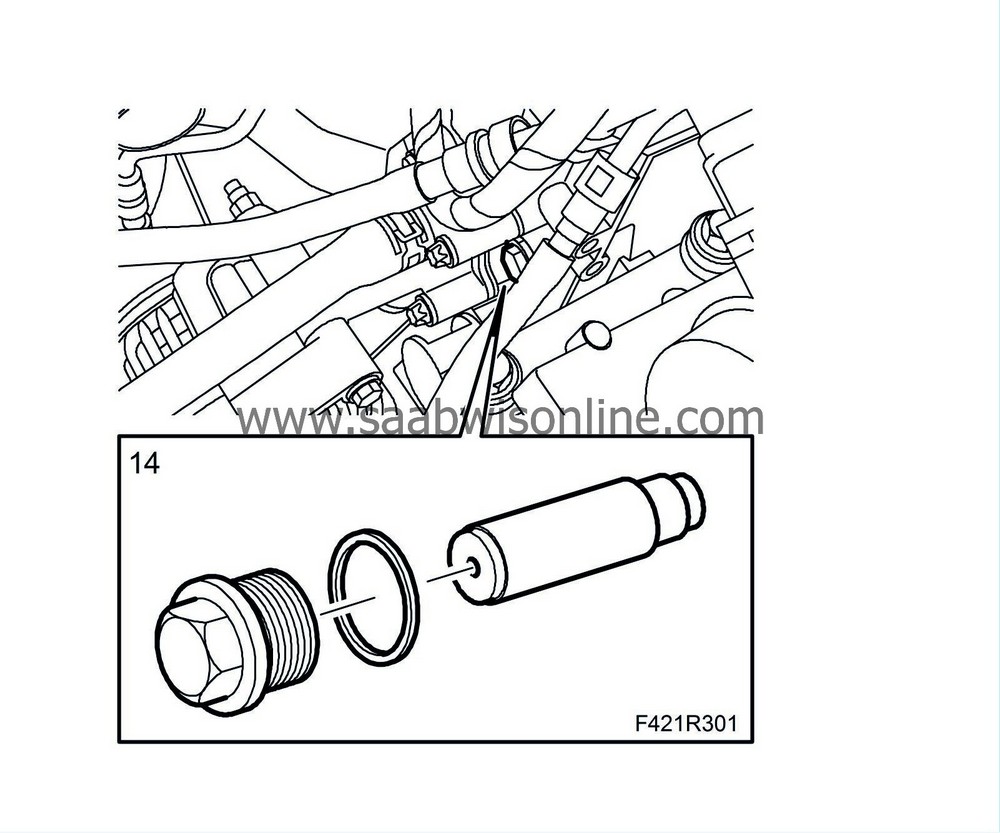
|
|
| 15. |
Removal all tools and gauges. Raise the car to remove
83 95 352 Adjustment tool, crankshaft
. Turn the crankshaft two turns to just before the mark for TDC for cylinder 1. Check that both cams for cylinder 1 point obliquely upward.
|
|
| 16. |
Raise the car and fit
83 95 352 Adjustment tool, crankshaft
into the hole for the crankshaft position sensor. Press the tool in while turning the crankshaft to zero. The tool should enter a recess in the crankshaft and lock it.
|
|
| 17. |
Lower the car and check that the markings on the crankshaft pulley and timing cover are aligned. Also, the arrow on the single camshaft sprocket by the fuel distribution pump should be aligned with the recess on the pump.
|
|
| 18. |
Insert
83 95 337 Adjustment tool, fuel pump
into the recess on the fuel distribution pump. If the gauge does not fit, the valve timing must be adjusted. Refer to
Adjusting valve timing
.
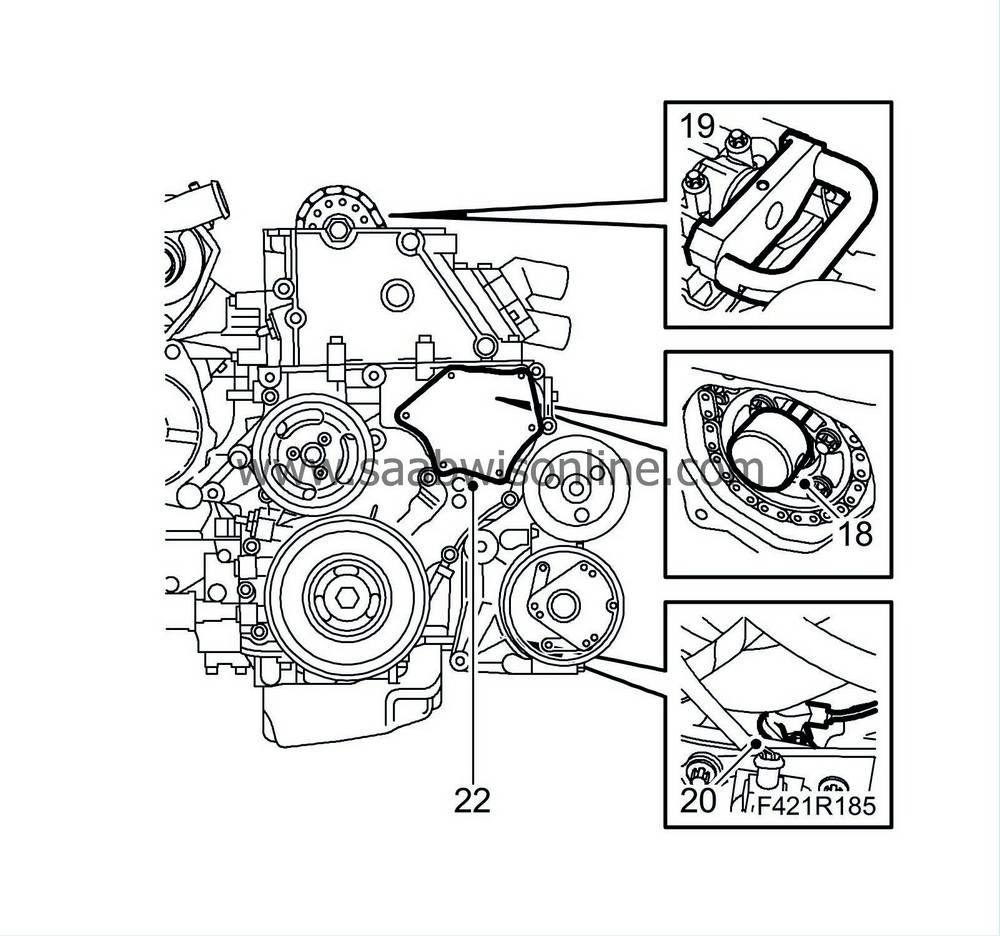
|
|
| 19. |
Fit
83 95 386 Adjustment tool, camshaft
to the camshaft and cylinder head. If the gauge does not fit, the valve timing must be adjusted. Refer to
Adjusting valve timing
. Remove the adjustment tools. Raise the car to remove
83 95 352 Adjustment tool, crankshaft
.
|
|
| 20. |
Fit the crankshaft position sensor with a new O-ring.
|
|
| 21. |
Lower the car and cover the opening in the timing cover with a lint free cloth. Clean any old gasket remains from the sealing surfaces and clean the sealing surface on the cover.
|
|
| 22. |
Apply a 2 mm bead of
83 95 691 Flange sealant
to the cover. Remove the cloth from the timing cover and fit the cover.
Tightening torque 6 Nm (5 lbf ft) |
|
| 23. |
Fit and adjust the engine pad to the body. Tighten the bolts between the engine pad and the bracket. The engine pad and bracket should be aligned with each other.
Tightening torque, bolt to body 40 Nm + 60° (30 + 60° lbf ft) Tightening torque, bolt to engine bracket 70 Nm + 60° (52 + 60° lbf ft) 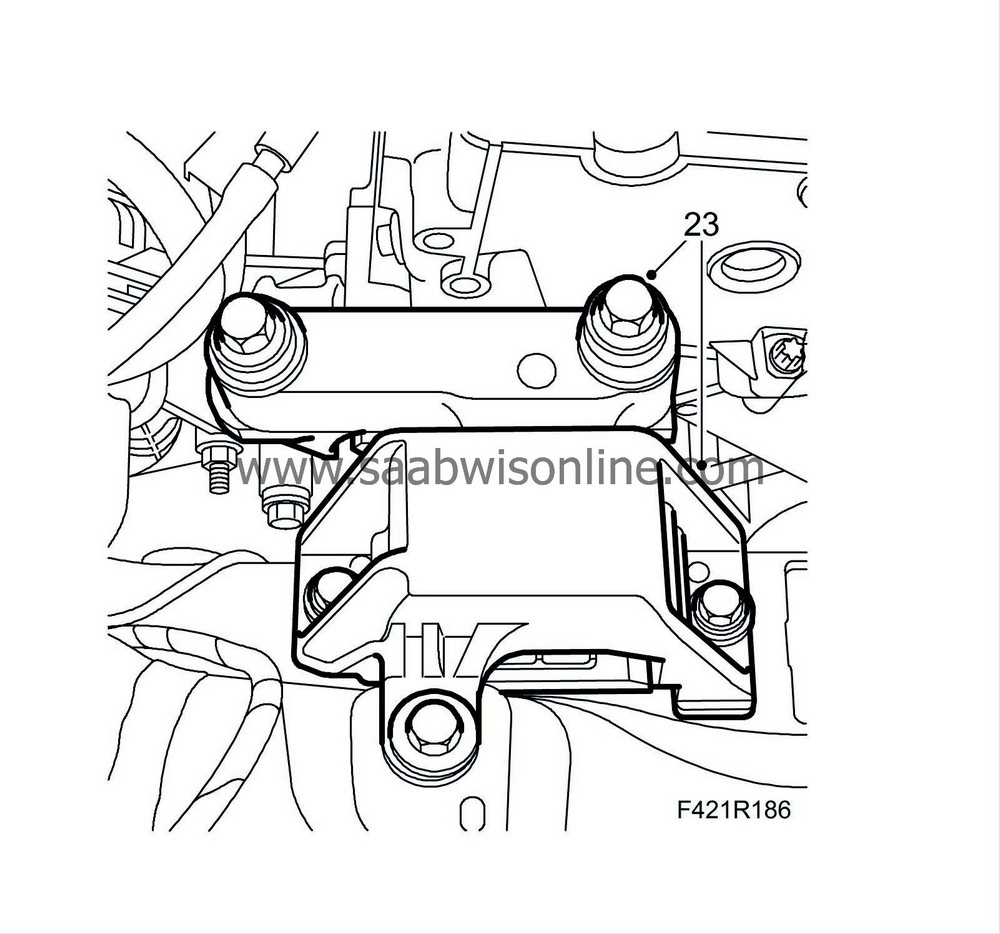
|
||||||||||
| 24. |
Raise the car and remove
83 96 152 Centring kit, engine
from the subframe.
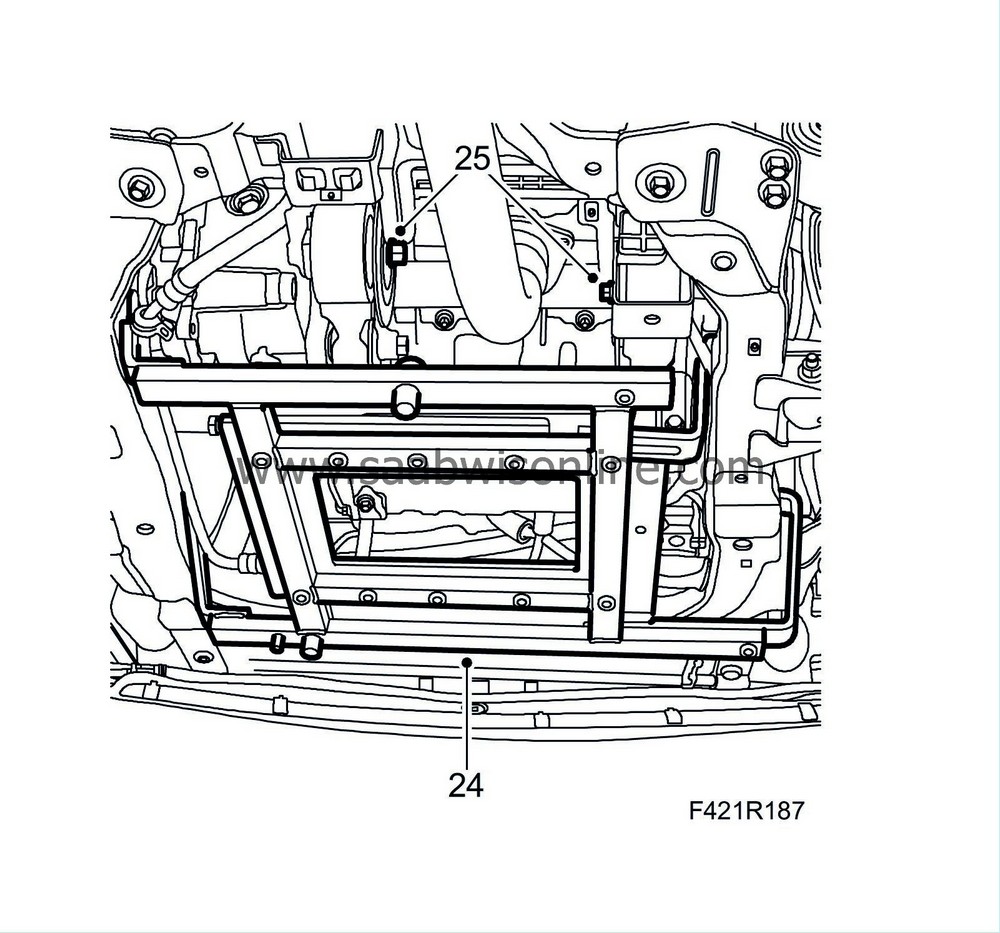
|
|
| 25. |
Tighten the rear bolts securing the torque arm.
Tightening torque 70 Nm + 90° (52 + 90° lbf ft) |
|
| 26. |
Fit the screws securing the clamps holding the power steering pipe to the subframe.
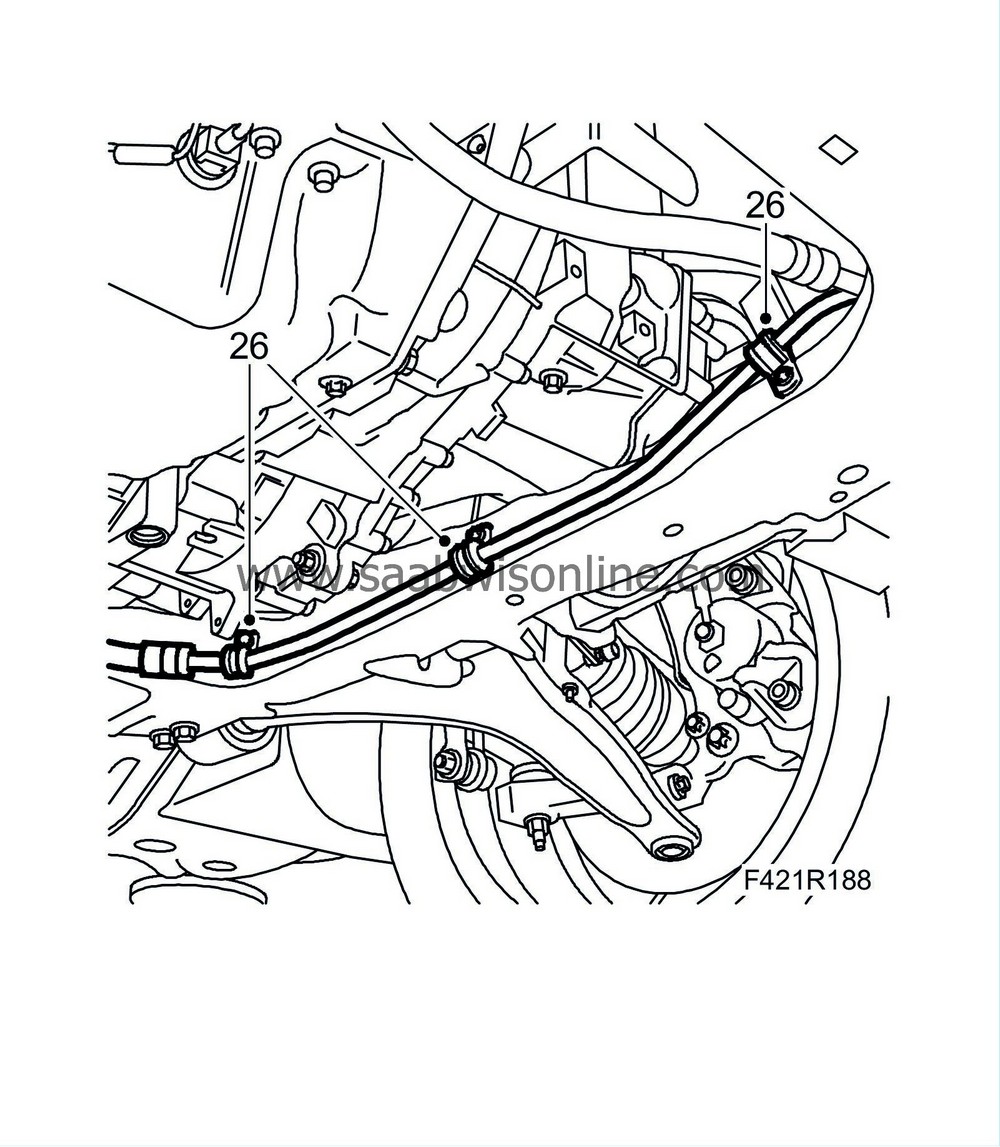
|
|
| 27. |
Raise the car and clean any gasket remains from the sealing surfaces of the cylinder head. Fit a new gasket to the camshaft cover. Apply
83 95 691 Flange sealant
to the sealing surface as illustrated and fit the camshaft cover.
Tightening torque 8 Nm (6 lbf ft) 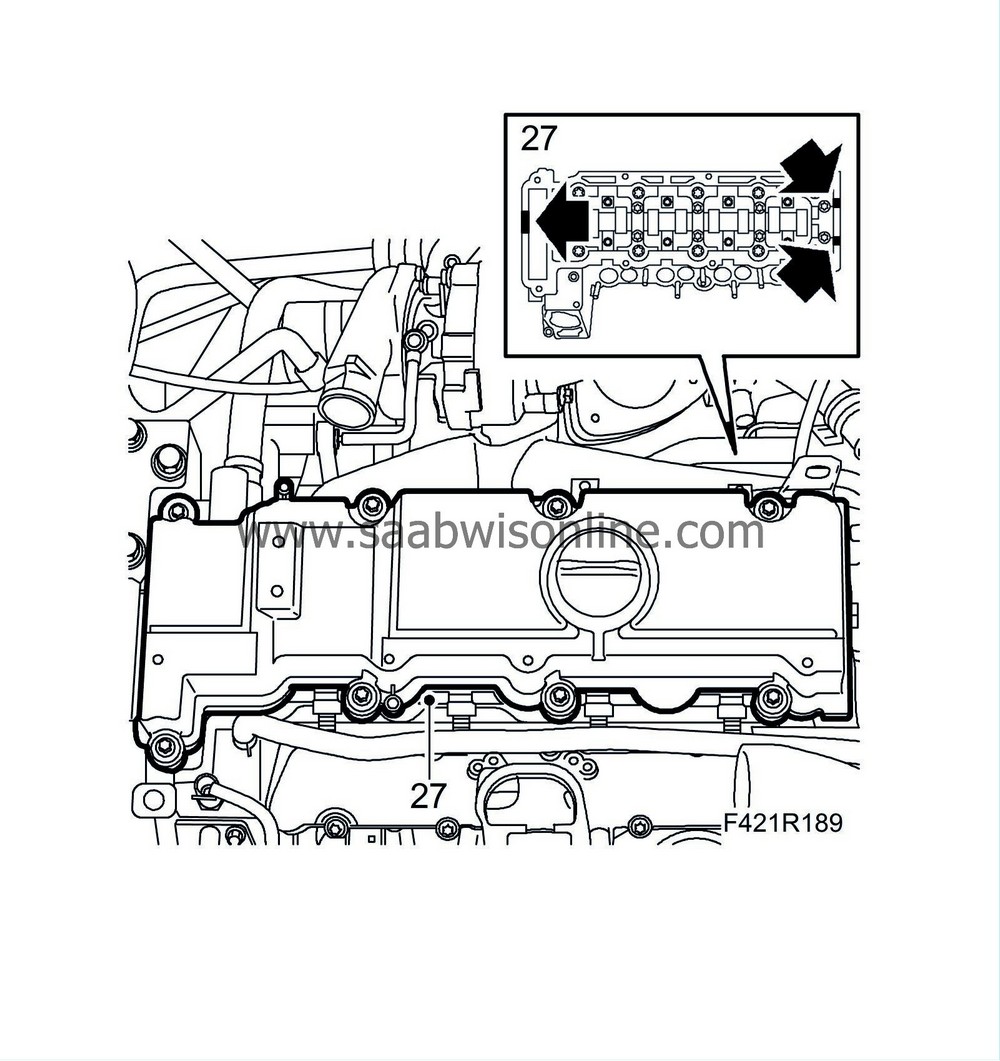
|
|
| 28. |
Position the vacuum pump. Apply
83 95 691 Flange sealant
as illustrated and fit the vacuum pump, adapter and a new gasket. Connect the hoses to the vacuum pump.
Tightening torque 8 Nm (6 lbf ft) 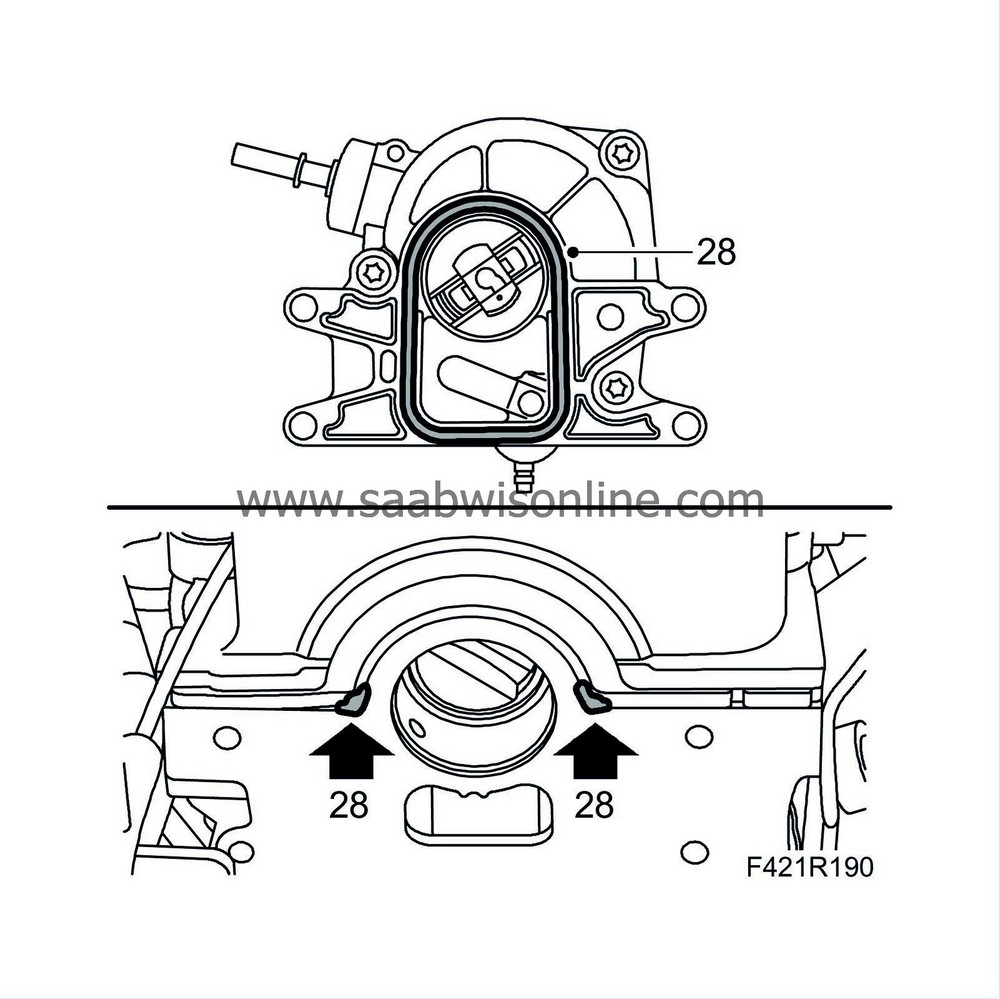
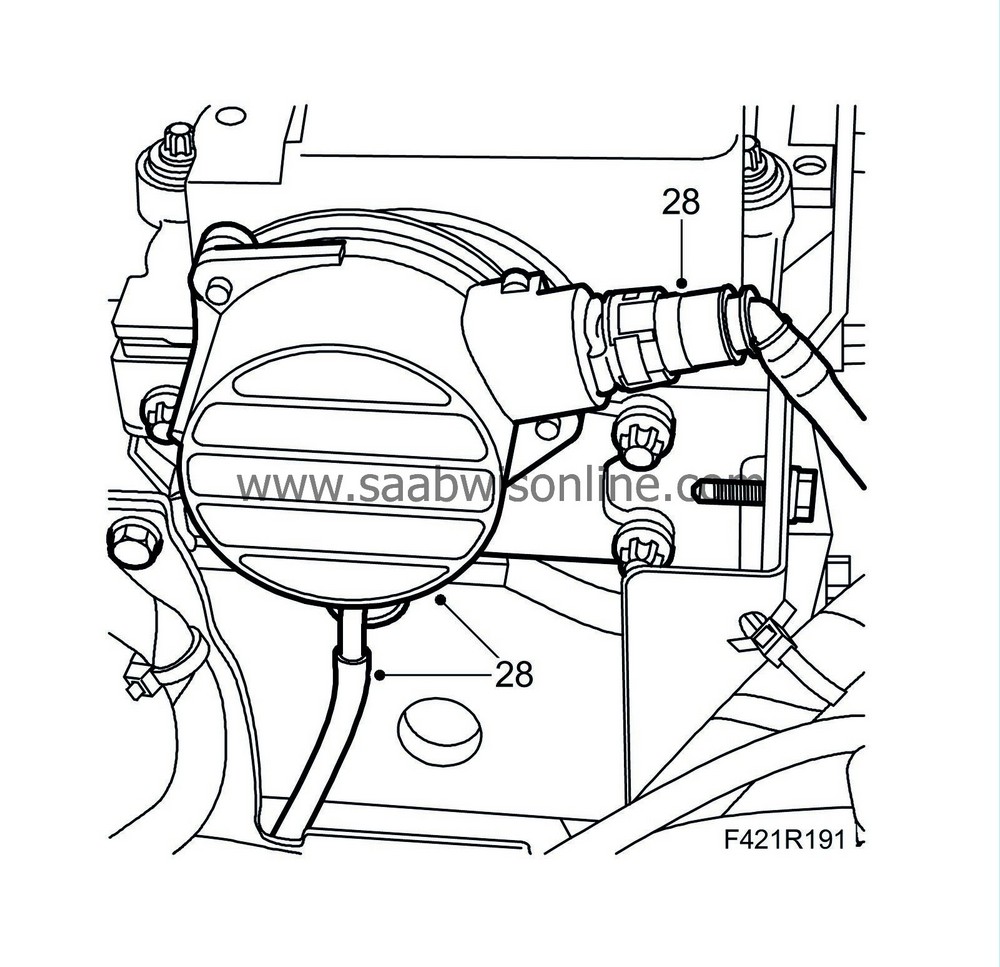
|
|
| 29. |
Fit the bolts securing the generator bracket and a new gasket.
Tightening torque 20 Nm (15 lbf ft) 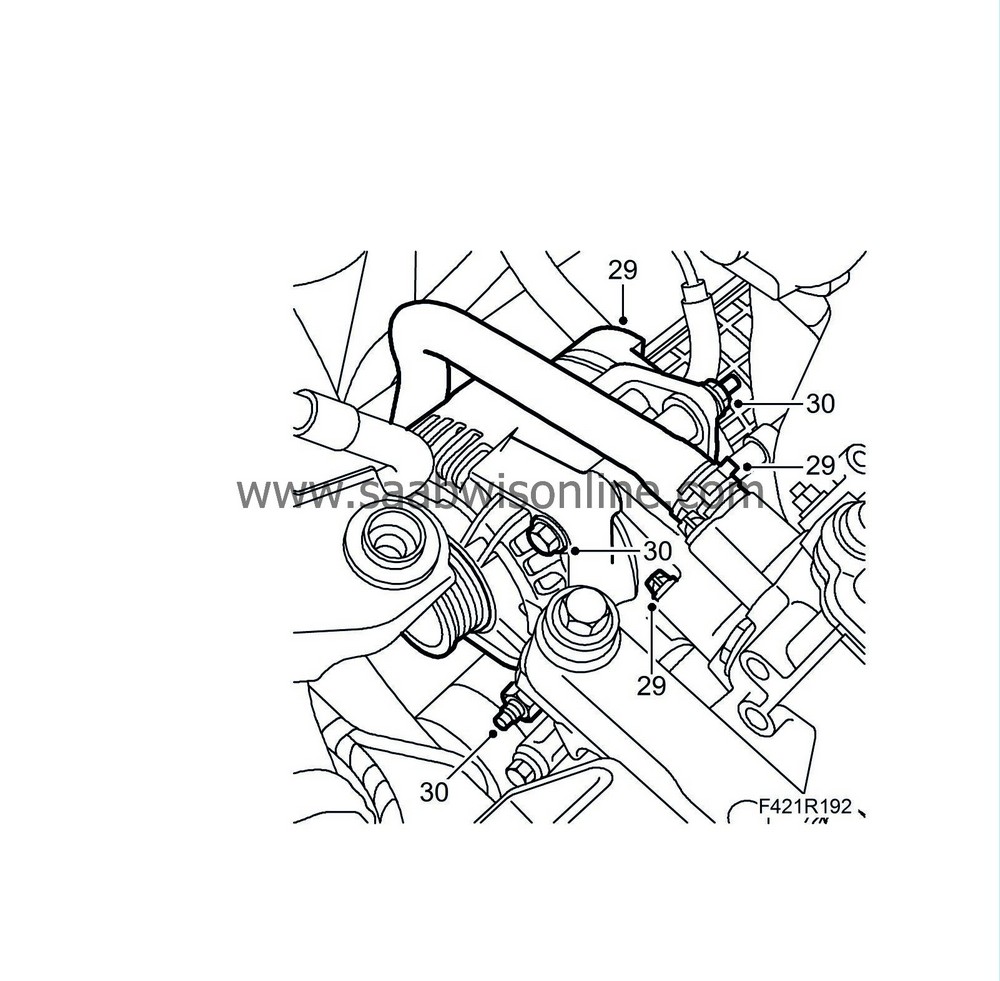
|
|
| 30. |
Fit the upper generator bolt and tighten the lower bolt.
Tightening torque 35 Nm (26 lbf ft) |
|
| 31. |
Fit the bolts securing the cable duct by the vacuum pump.
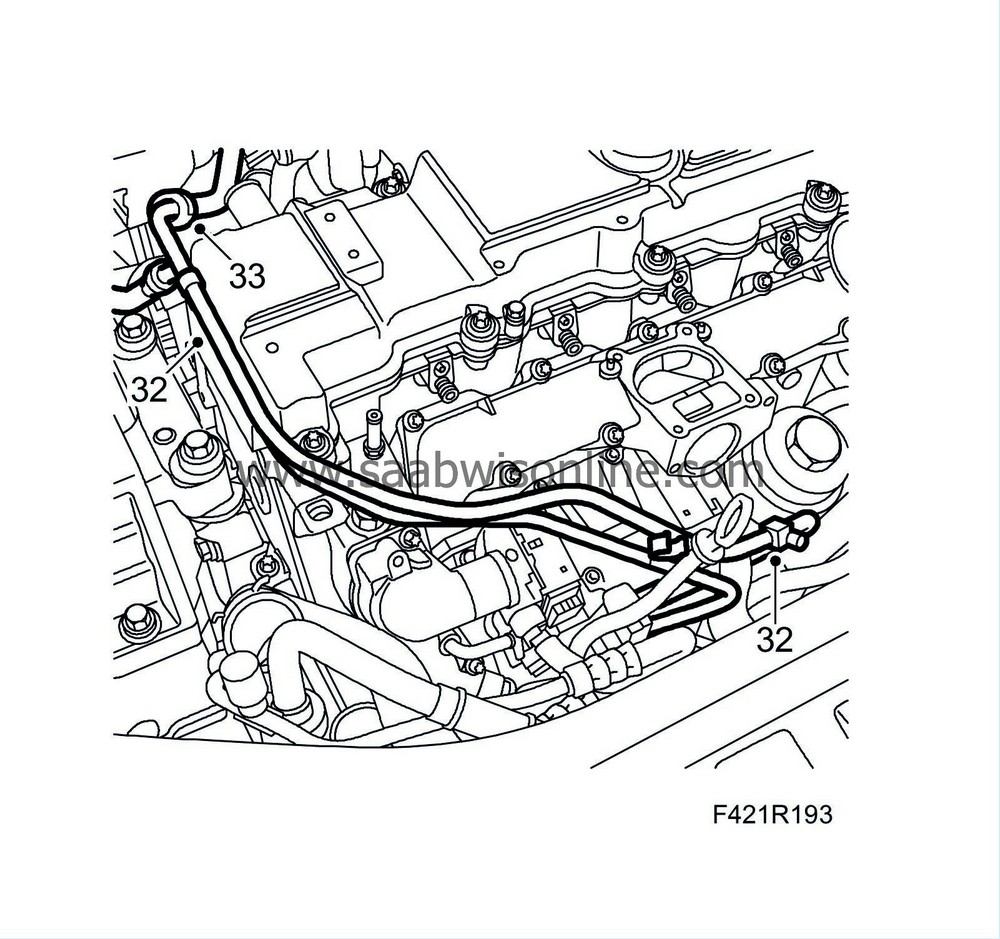
|
|
| 32. |
Fit a new fuel return hose to the deliver line. Fit the return and delivery fuel lines to the fuel pump using new seals. Do not fully tighten the connections.
|
|
| 33. |
Connect the fuel lines to the lines from the tank. Align the lines with the outlet in the camshaft cover and tighten the connections on the fuel pump. Hold the fuel lines still to prevent them twisting when tightened.
Tightening torque 25 Nm (19 lbf ft) |
|
| 34. |
Connect the three hoses to the thermostat housing.
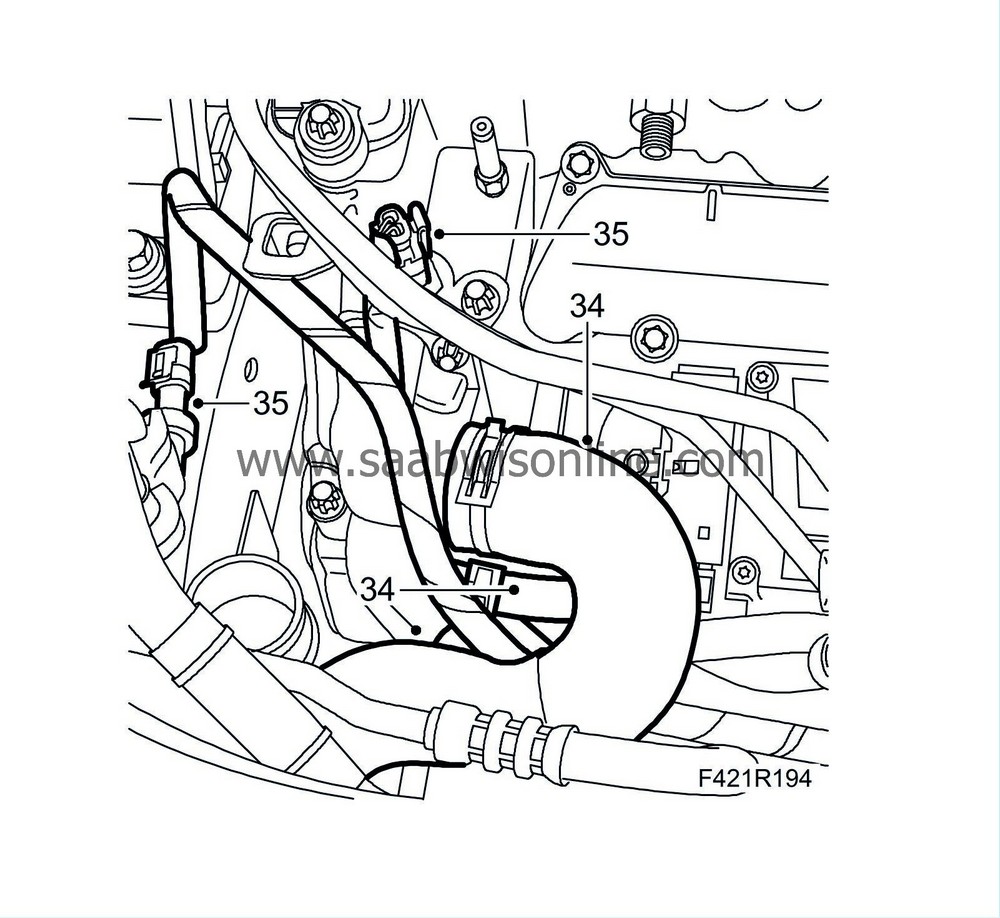
|
|
| 35. |
Plug in the connectors for the A/C pressure sensor and coolant temperature sensor.
|
|
| 36. |
Fit the fuel distribution pipes to their original positions with the clamps.
Tightening torque 25 Nm (19 lbf ft) |
|
| 37. |
Fit the new return hoses to the fuel bridges and connect these to the new fuel return hose from the fuel supply.
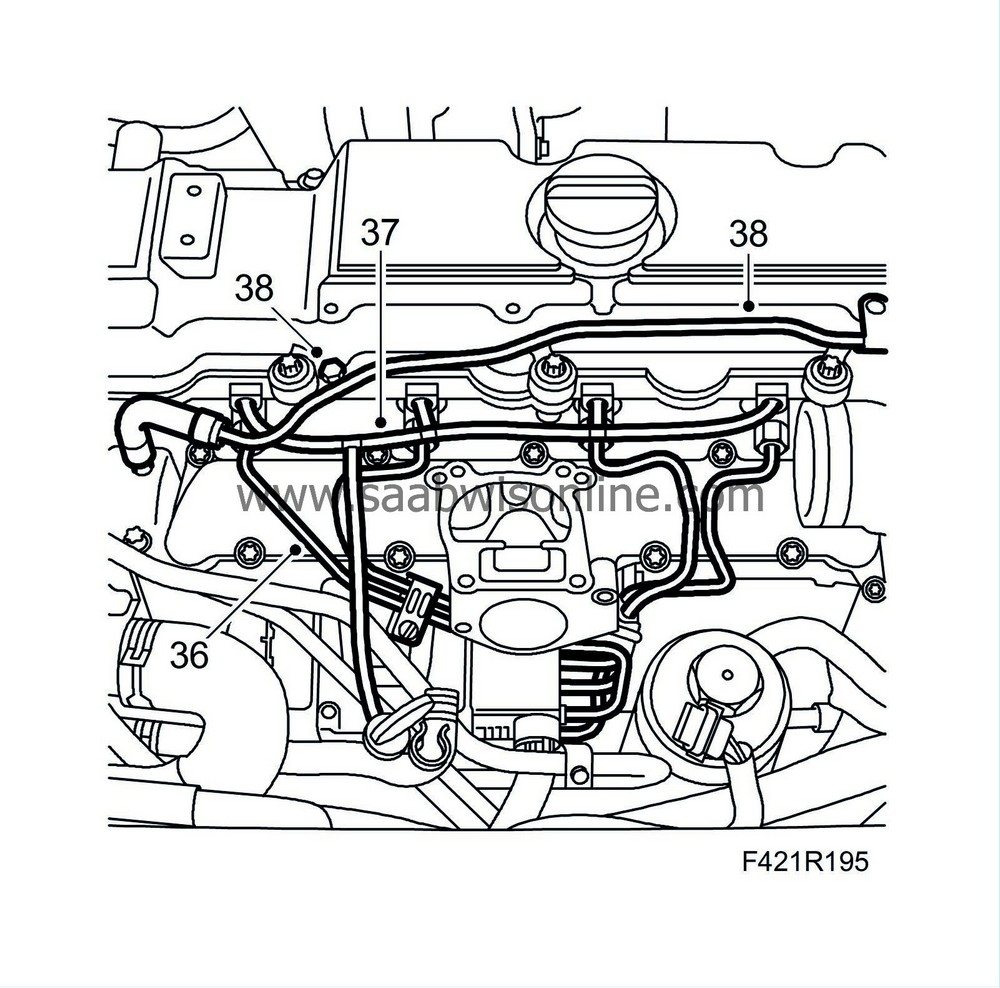
|
|
| 38. |
Fit the coolant pipe and bracket to the cylinder head.
|
|
| 39. |
Fit the EGR valve with a new seal.
Tightening torque 25 Nm (19 lbf ft) 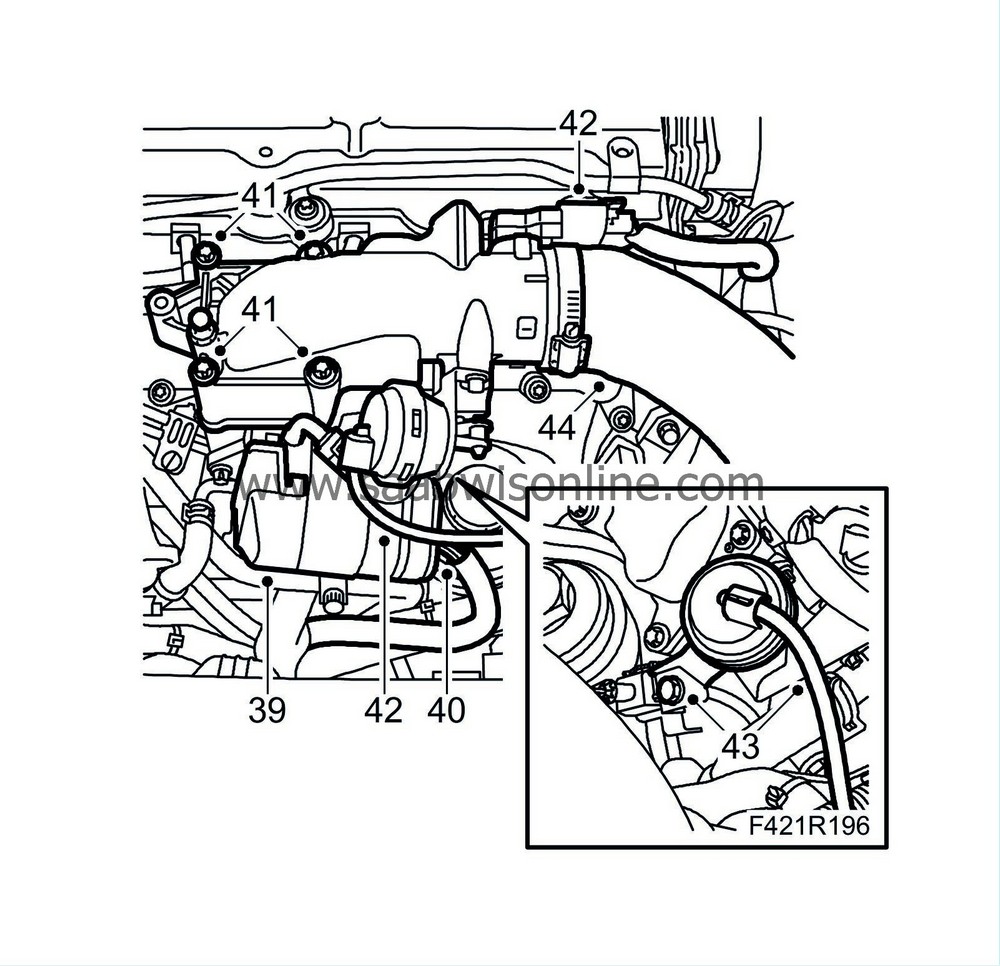
|
|
| 40. |
Connect the EGR valve connector and coolant hoses.
Tightening torque 25 Nm (19 lbf ft) |
|
| 41. |
Fit the throttle body with a new seal.
Tightening torque 8 Nm (6 lbf ft) |
|
| 42. |
Plug in connector for the pressure/temperature sensor and connect the vacuum hose to the throttle body.
|
|
| 43. |
Fit the screw securing the connector bracket for the crankshaft position sensor. Connect the hose to the swirl throttle's vacuum box.
|
||||||||||
| 44. |
Fit the turbocharger delivery hose to the throttle body.
|
|
| 45. |
Fit the exhaust manifold support.
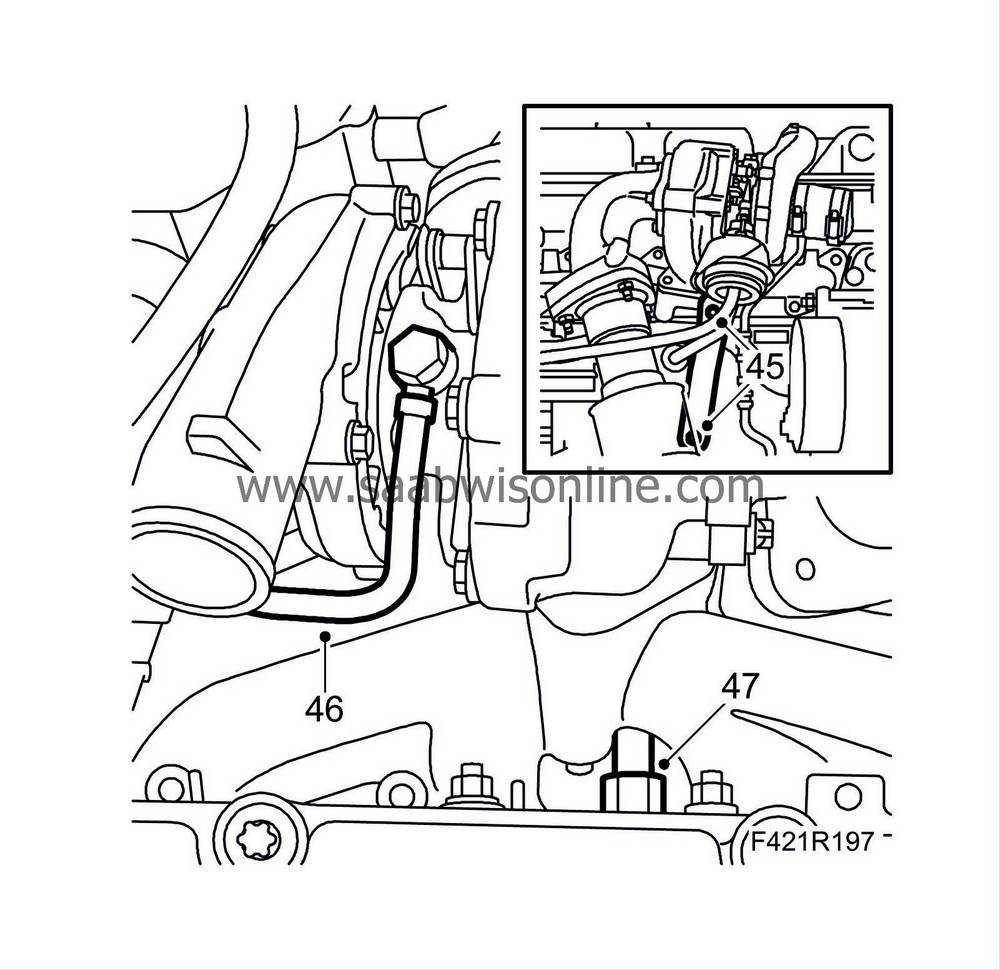
|
|
| 46. |
Connect the oil delivery pipe to the turbocharger. Use new seals.
Tightening torque 22 Nm (16 lbf ft) |
|
| 47. |
Connect the oil return pipe from the turbocharger to the cylinder block.
Tightening torque 15 Nm (11 lbf ft) |
|
| 48. |
Fit the bolts securing the generator and starter motor cable duct.
|
|
| 49. |
Fit the heat shield over the starter motor.
|
|
| 50. |
Fit the catalytic converter with a new gasket. Apply
30 20 971 Screw-thread paste
to the threads and thread the nuts securing the exhaust pipe and turbocharger. Connect the hose to the turbocharger vacuum box.
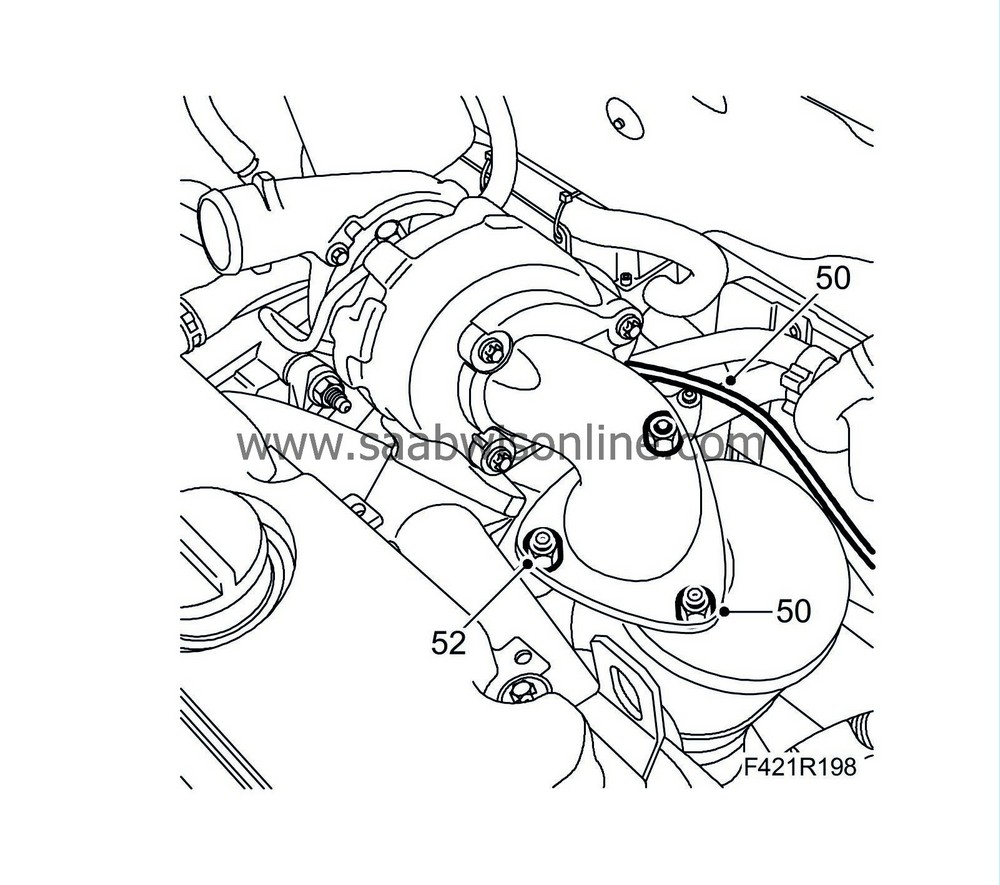
|
|
| 51. |
Raise the car and fit the catalytic convert bracket to the intermediate shaft. Thread the nuts.
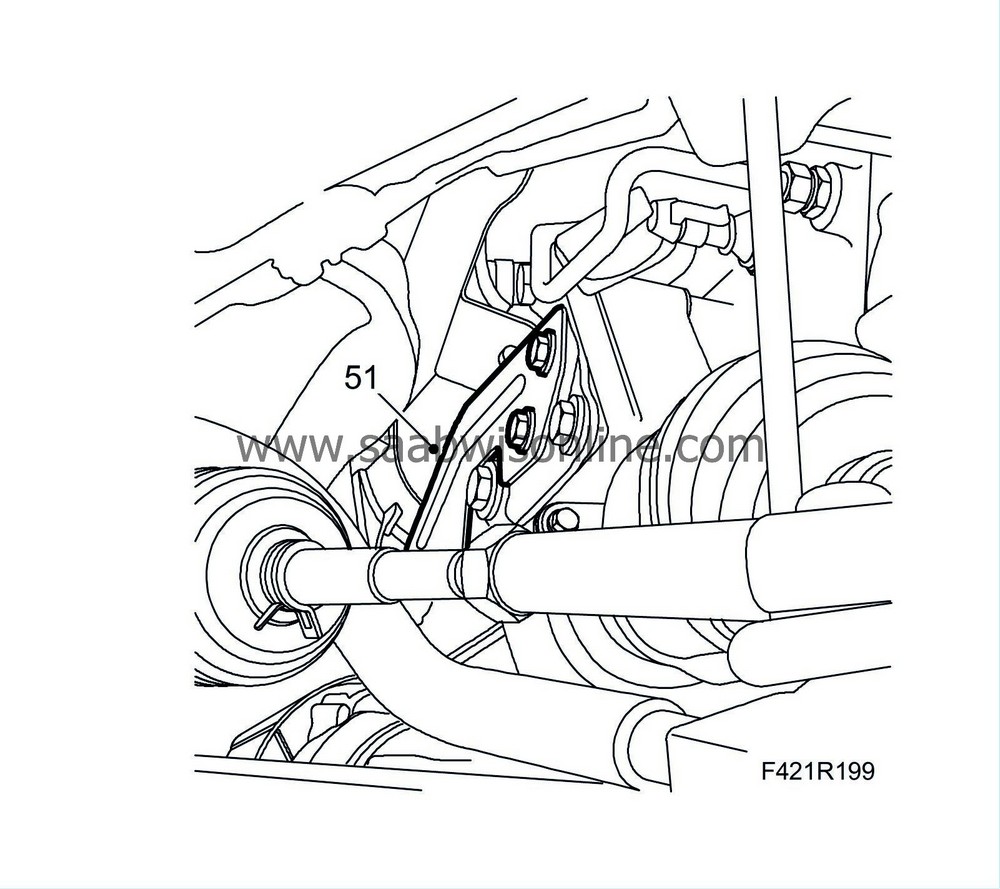
|
|
| 52. |
Tighten the front nut securing the catalytic converter to the turbocharger. Then tighten the bolts on the intermediate shaft and the nuts on the catalytic converter bracket. Fit the front exhaust pipe using a new gasket. Remove the strap.
Tightening torque, exhaust pipe nuts 25 Nm (19 lbf ft) Tightening torque, bracket bolts 25 Nm (19 lbf ft) 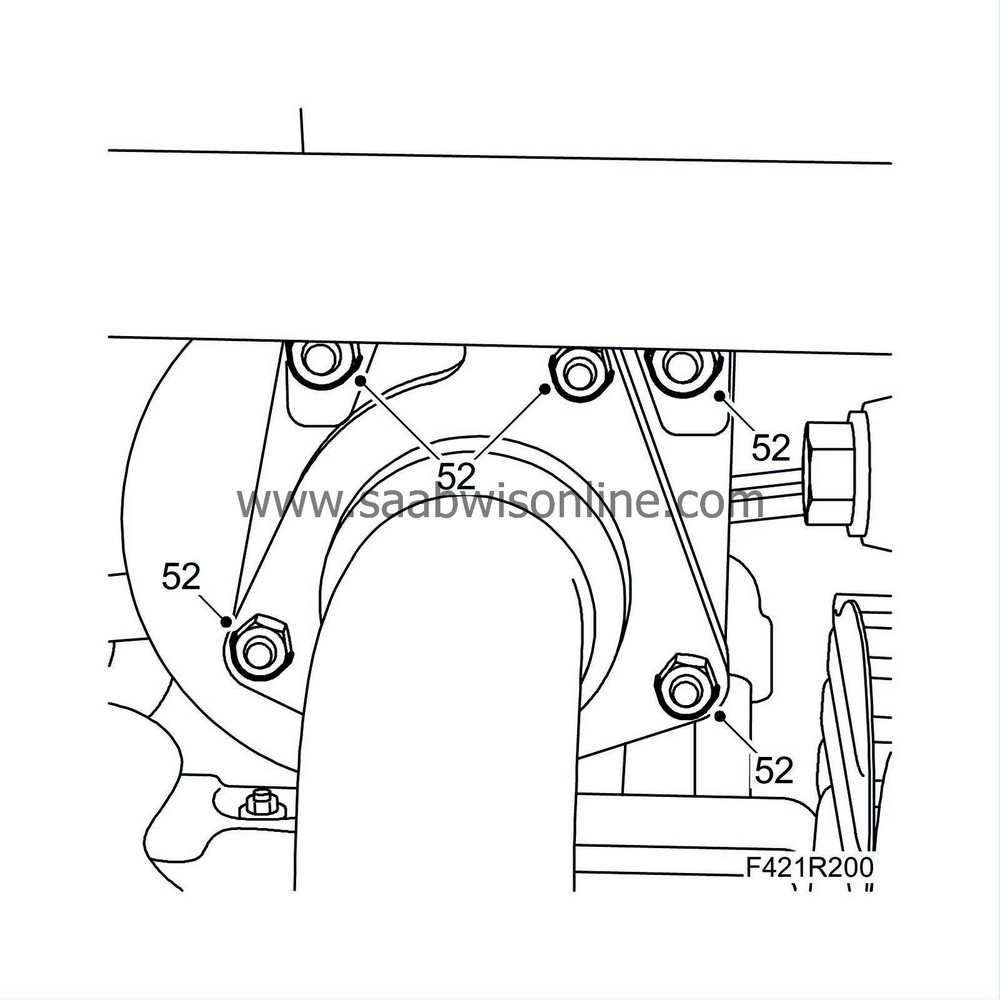
|
|
| 53. |
Fit the coolant pipe mounting to the gearbox and cylinder block.
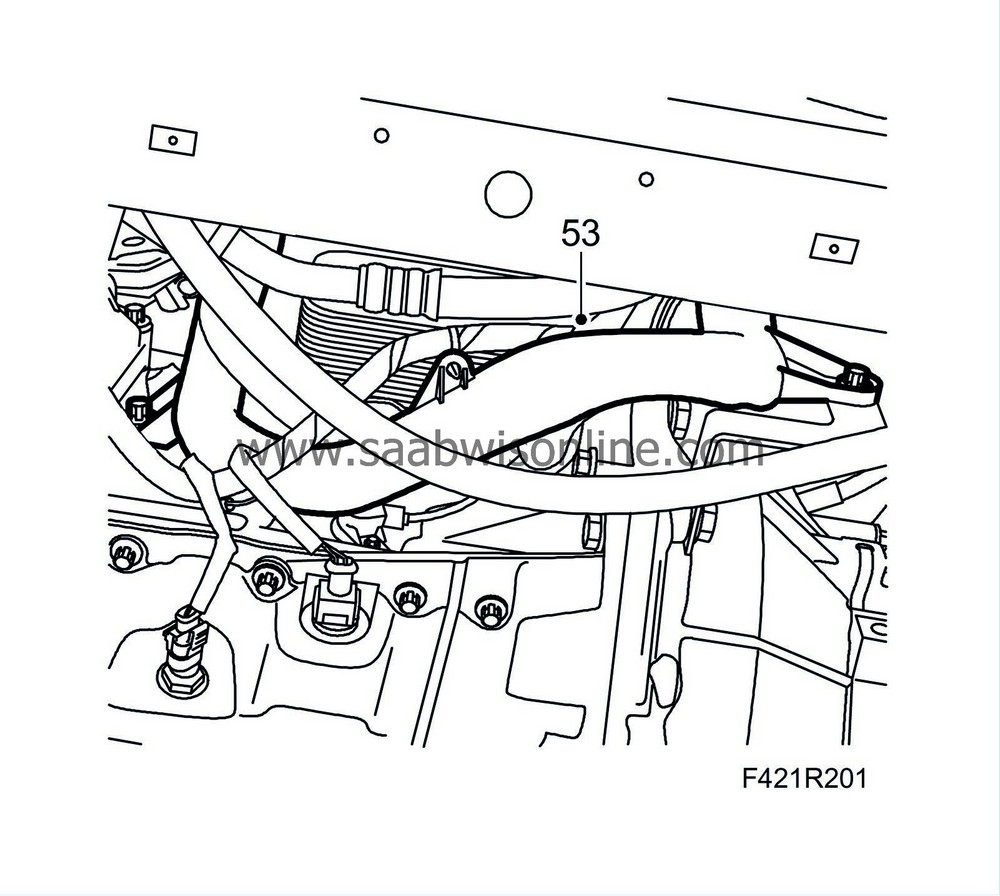
|
|
| 54. |
Fit the belt tensioner.
Tightening torque, lower screw 24 Nm (18 lbf ft) Tightening torque, upper screw 42 Nm (31 lbf ft) 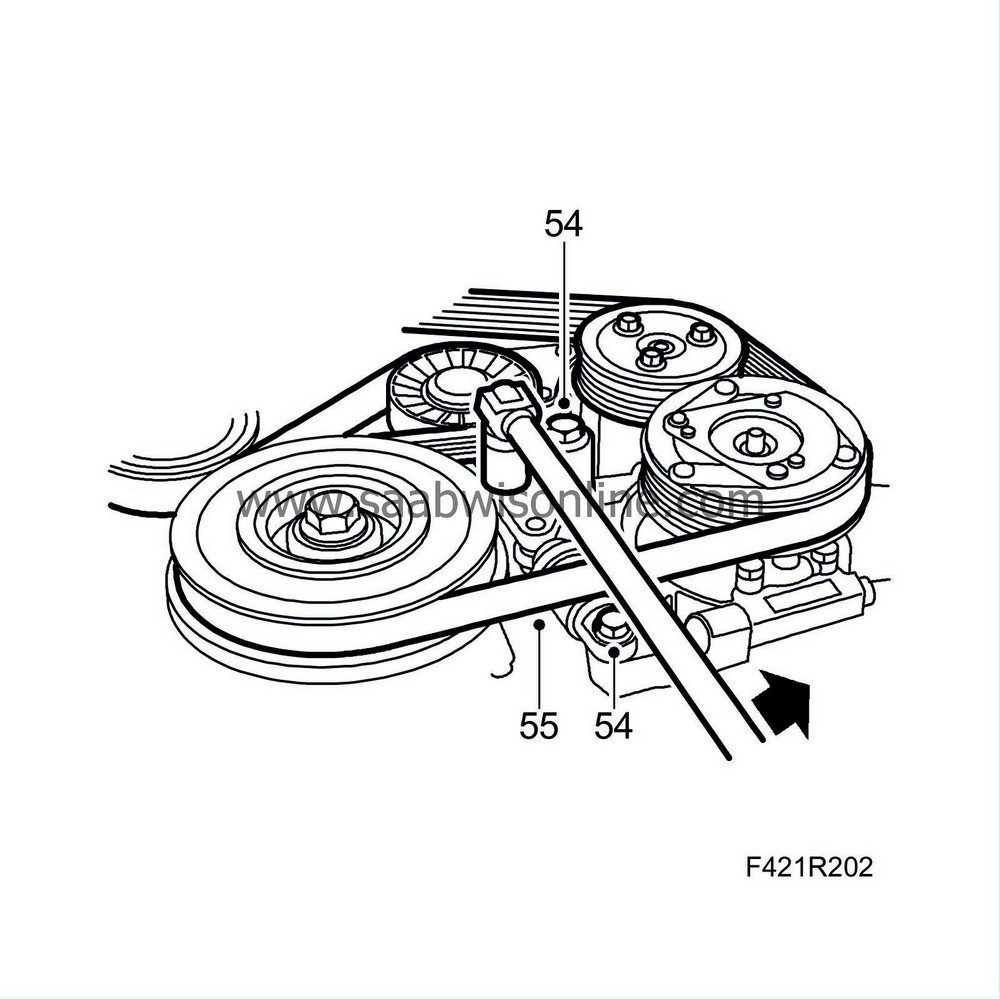
|
|
| 55. |
Release the tension of the poly-V-belt and fit it in the direction of rotation marked.
|
|
| 56. |
Fit the lower engine cover.
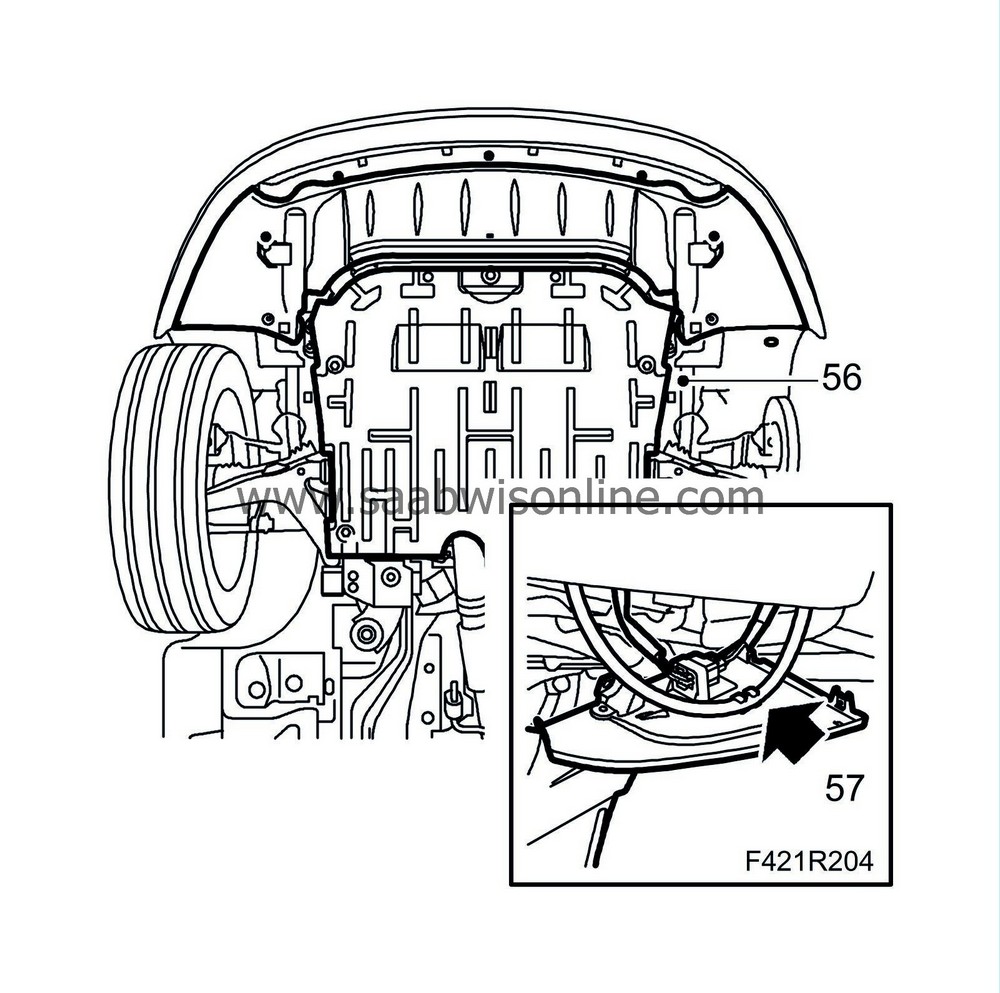
|
|
| 57. |
Fit the spoiler shield. Connect the headlight washer hose and fit and plug in the connector.
|
|
| 58. |
Lower the car and fit the right-hand wing liner and front right wheel. See
Wheels
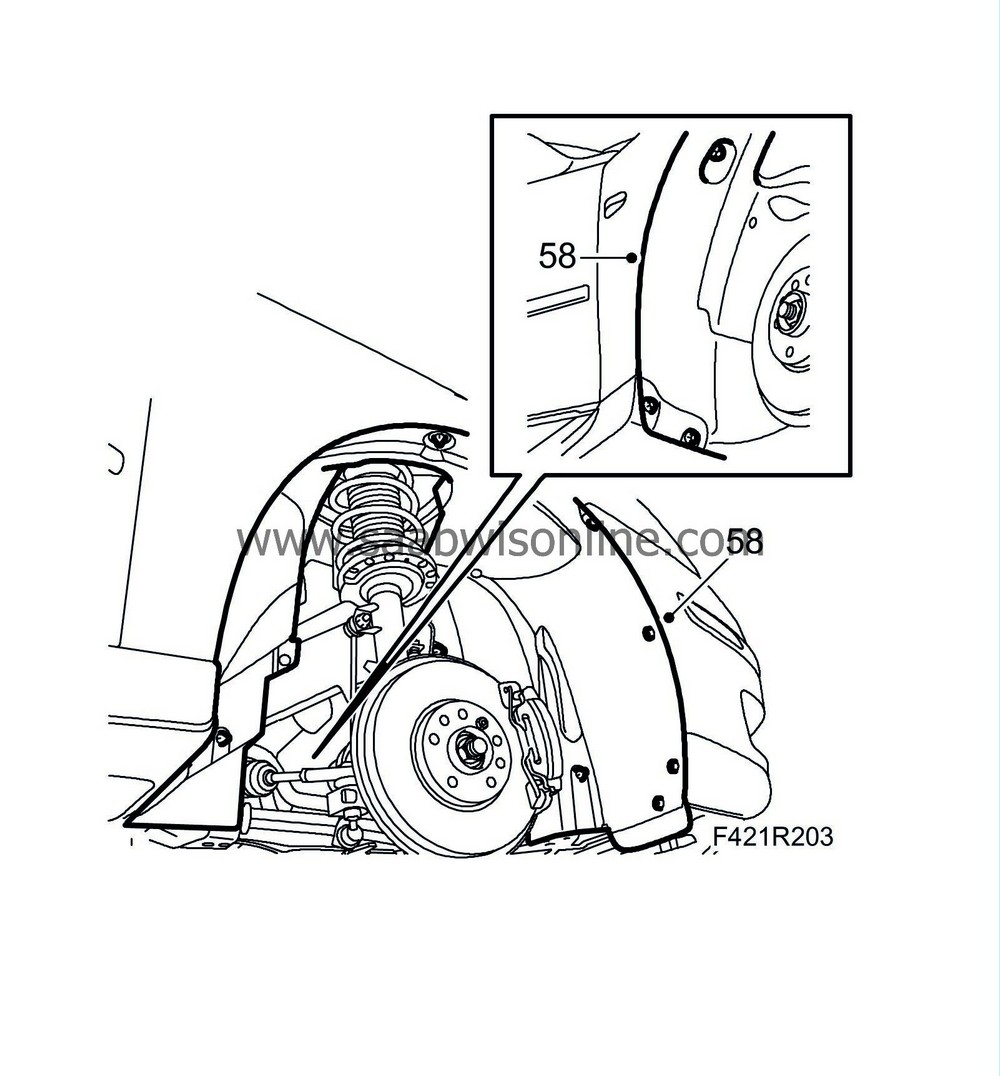
|
|
| 59. |
Tighten the rear nuts on the catalytic converter and fit the heat shields over the exhaust manifold and turbocharger.
Tightening torque, rear nuts 25 Nm (18 lbf ft) 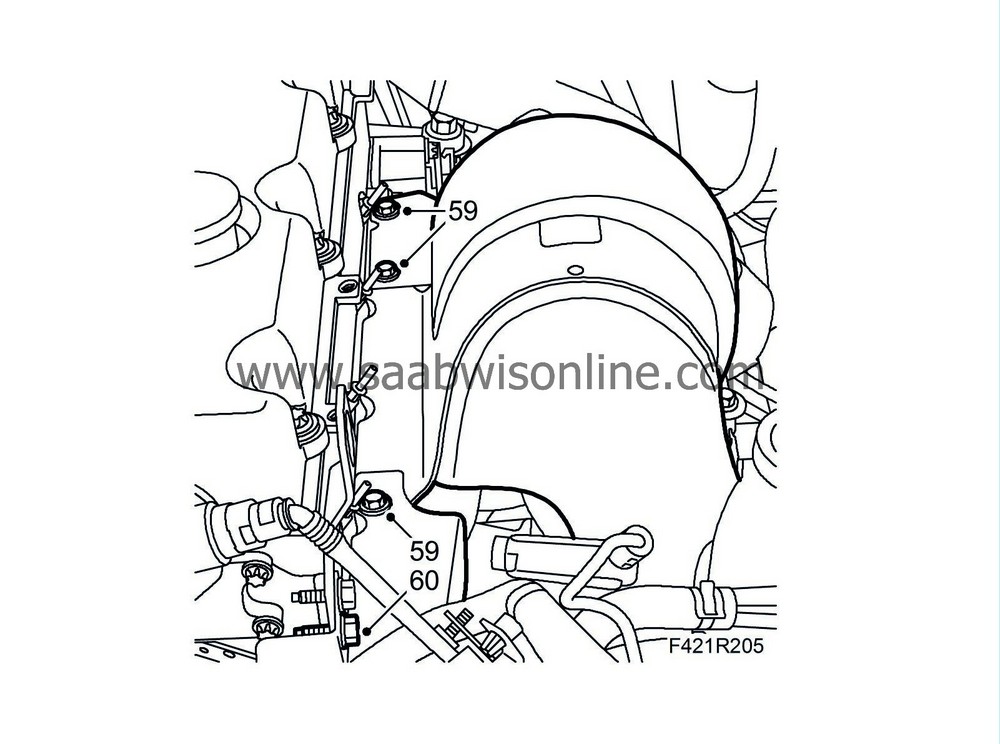
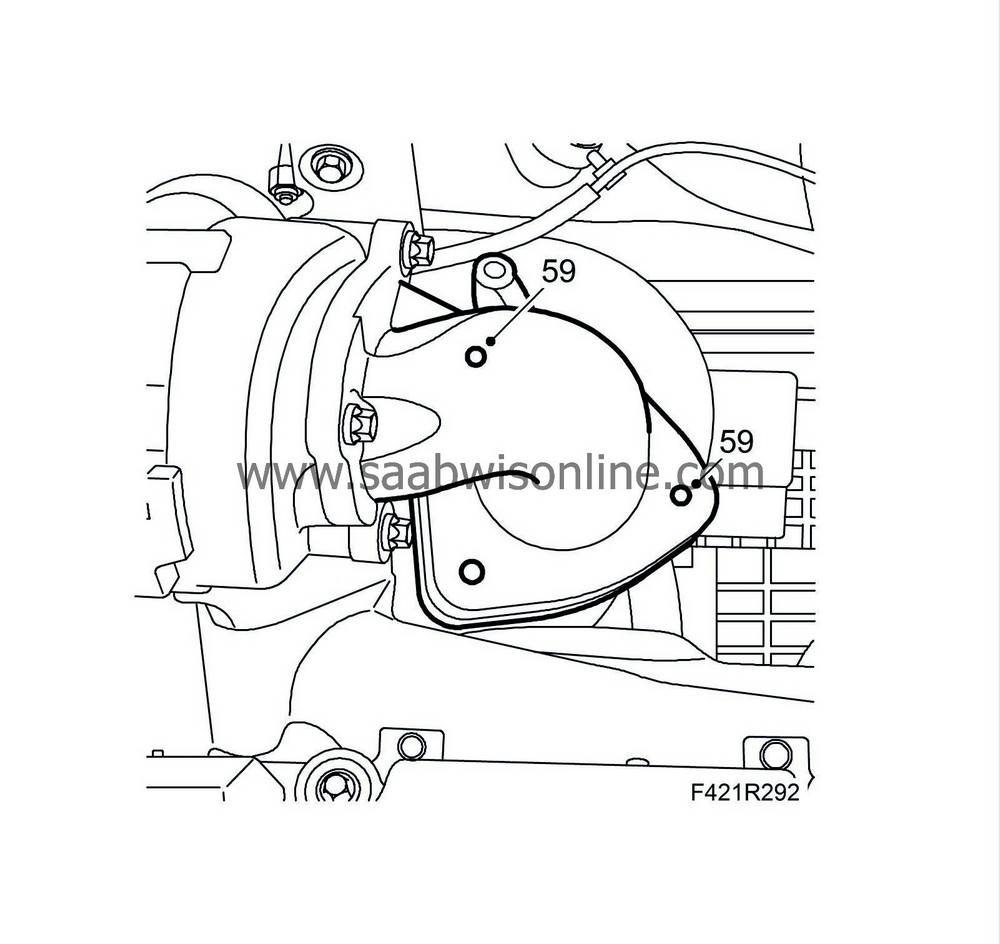
|
|
| 60. |
Fit the lower bolt securing the cable duct and lifting eye.
|
|
| 61. |
Connect the glow plug connectors.
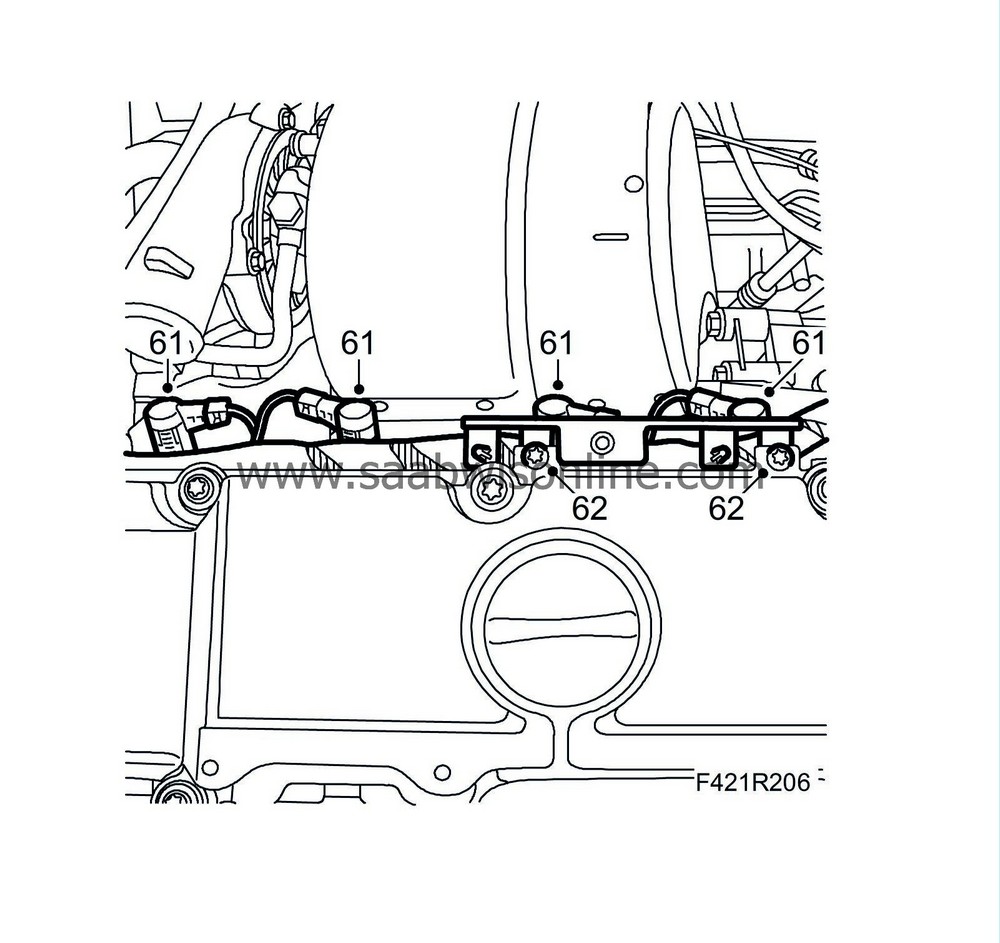
|
|
| 62. |
Fit the rear wiring harness mounting to the camshaft cover.
|
|
| 63. |
Fit the charge air hose and charge air pipe to the turbocharger and the charge air pipe to the fan cowling.
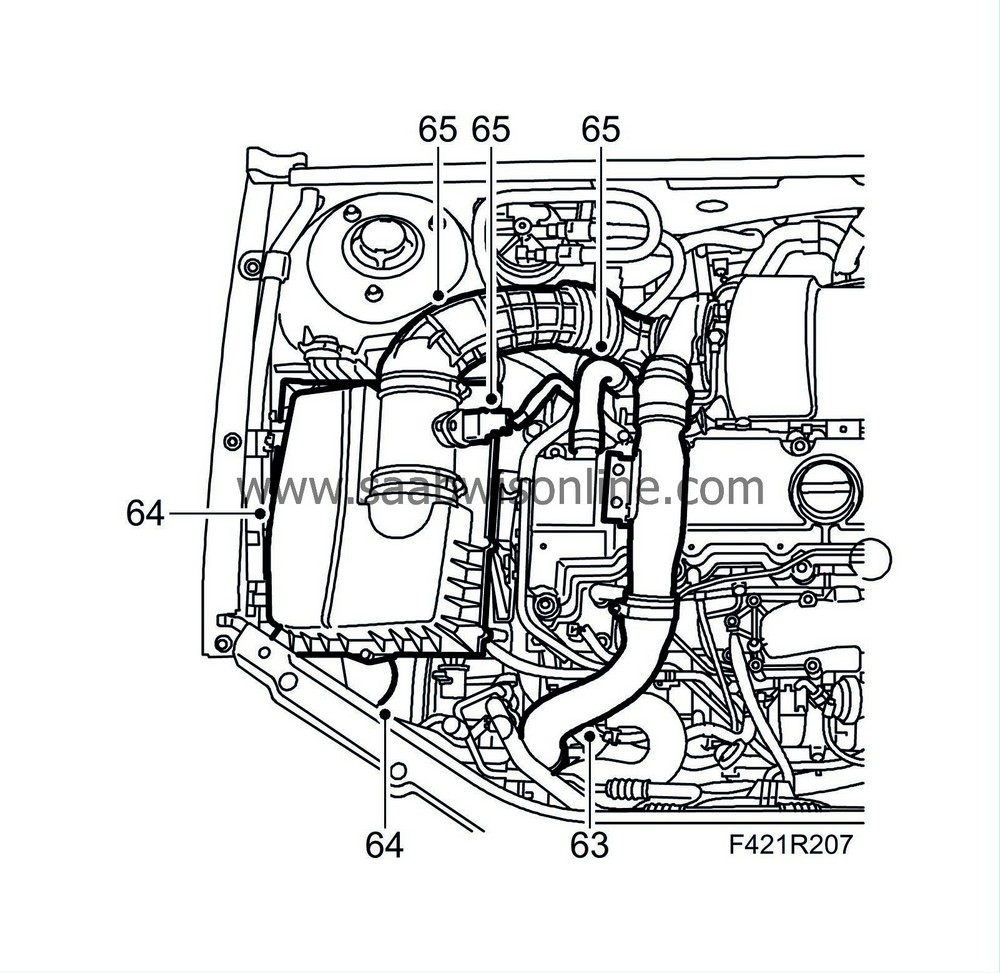
|
|
| 64. |
Fit the air filter housing and connect the intake hose. Fit the air filter and air filter housing lid.
|
|
| 65. |
Connect the crankcase ventilation hose and plug in the mass air flow sensor. Fit the turbocharger intake hose.
|
|
| 66. |
Connect the negative battery cable and fit the battery cover.
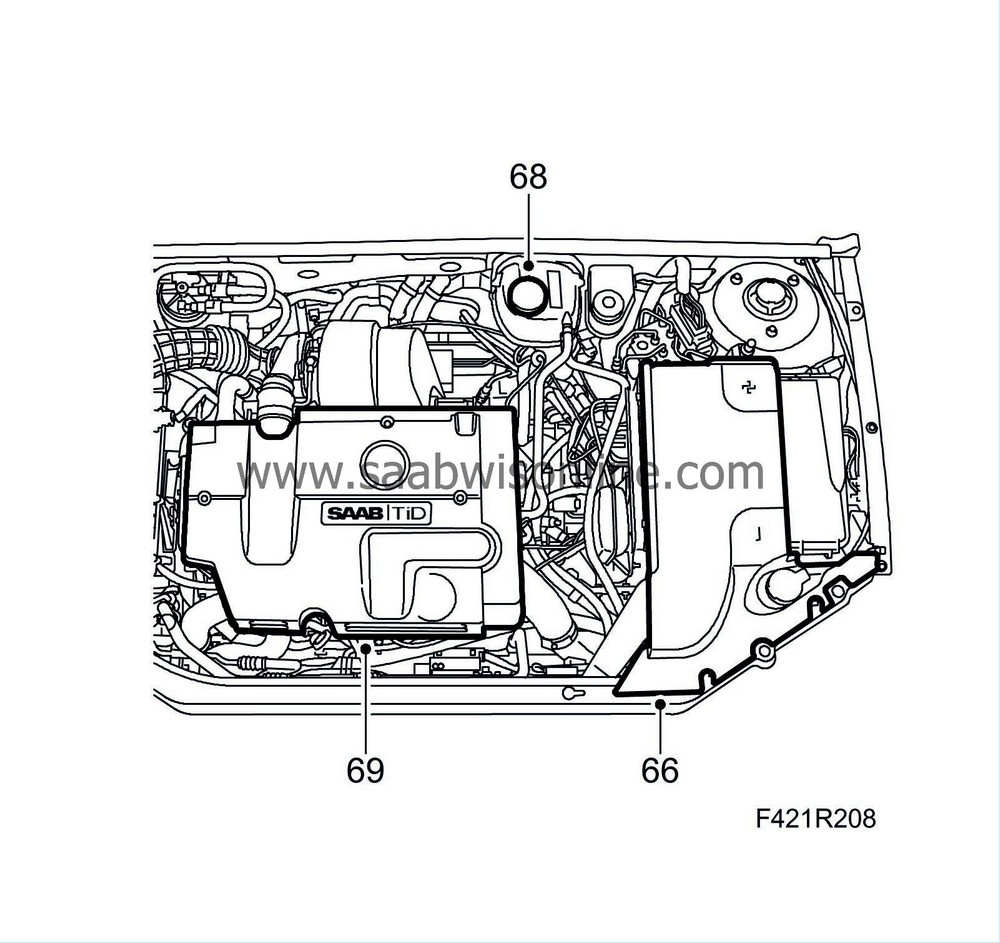
|
|
| 67. |
Bleed the fuel system, referring to
Bleeding of fuel lines
.
|
|
| 68. |
Check the engine oil level and adjust as necessary. Fill the cooling system to about 20 mm above the mark on the expansion tank.
|
|
| 69. |
Fit the upper engine cover.
|
|
| 70. |
Remove the covers from the wings and return the electrical system to its original state. Refer to
Procedures after reconnecting the battery
.
|
|

 Warning
Warning
